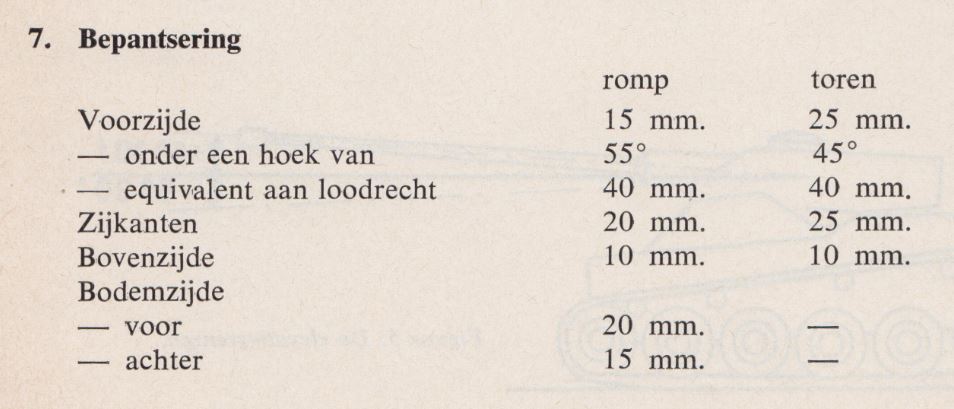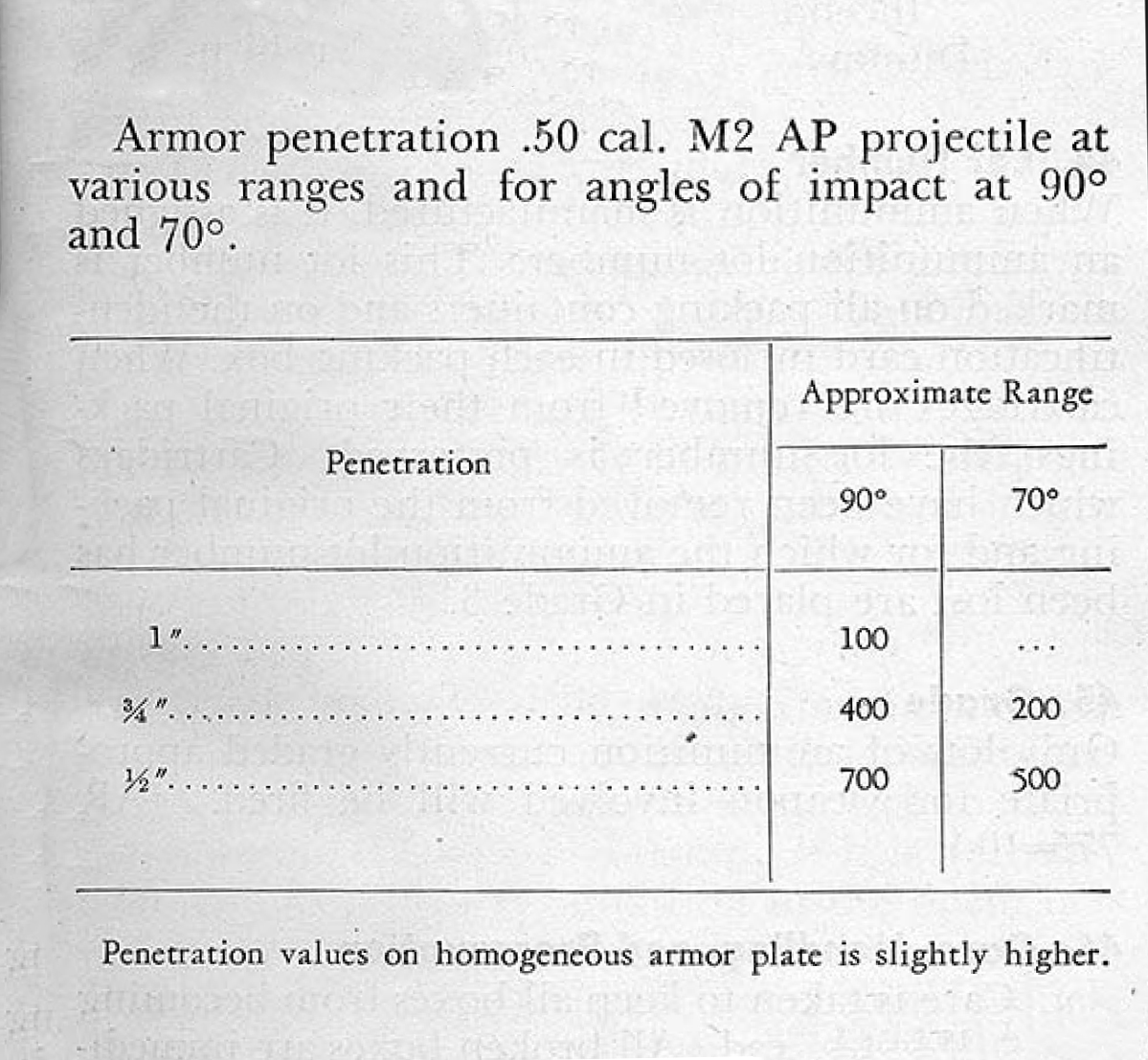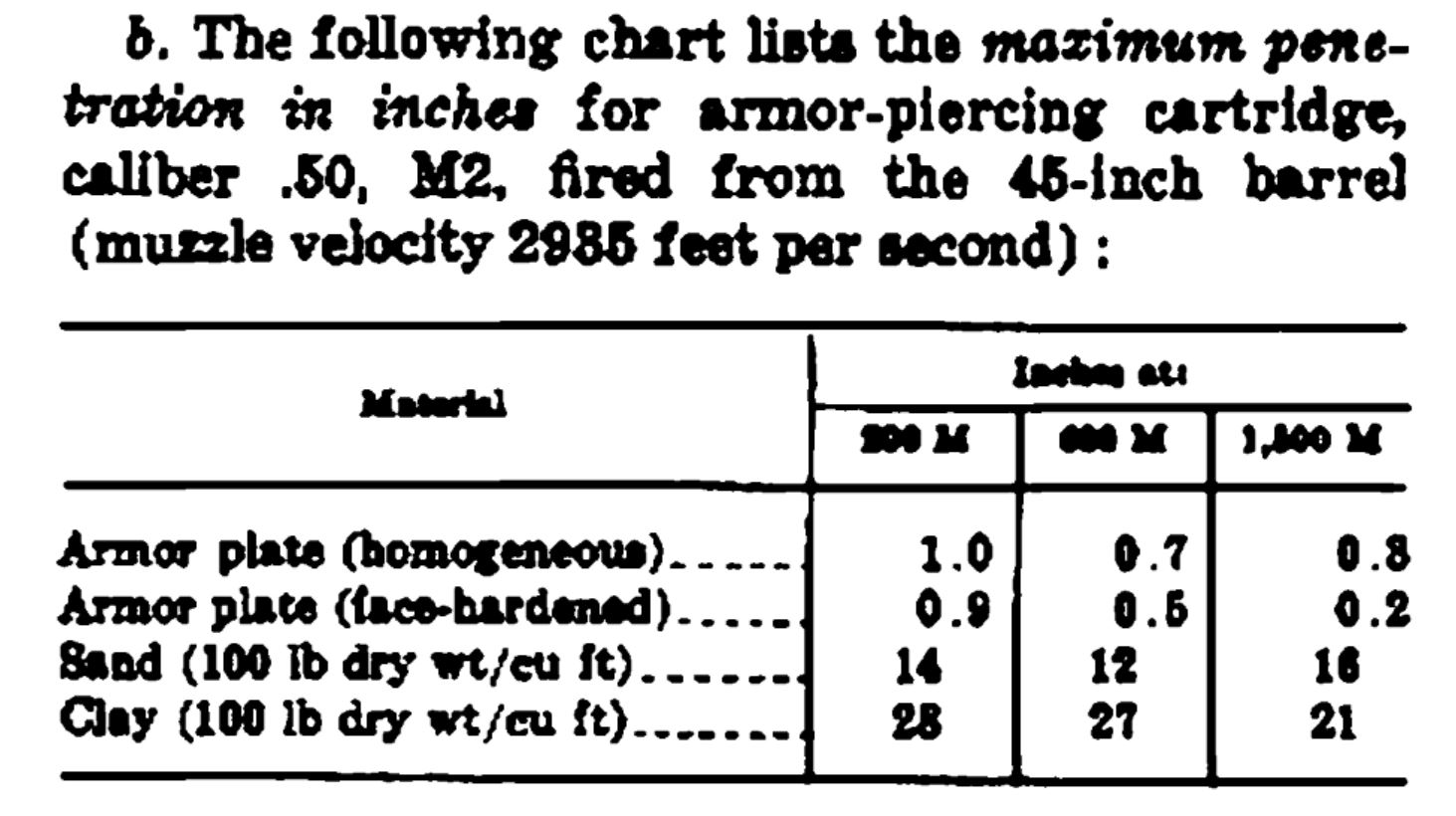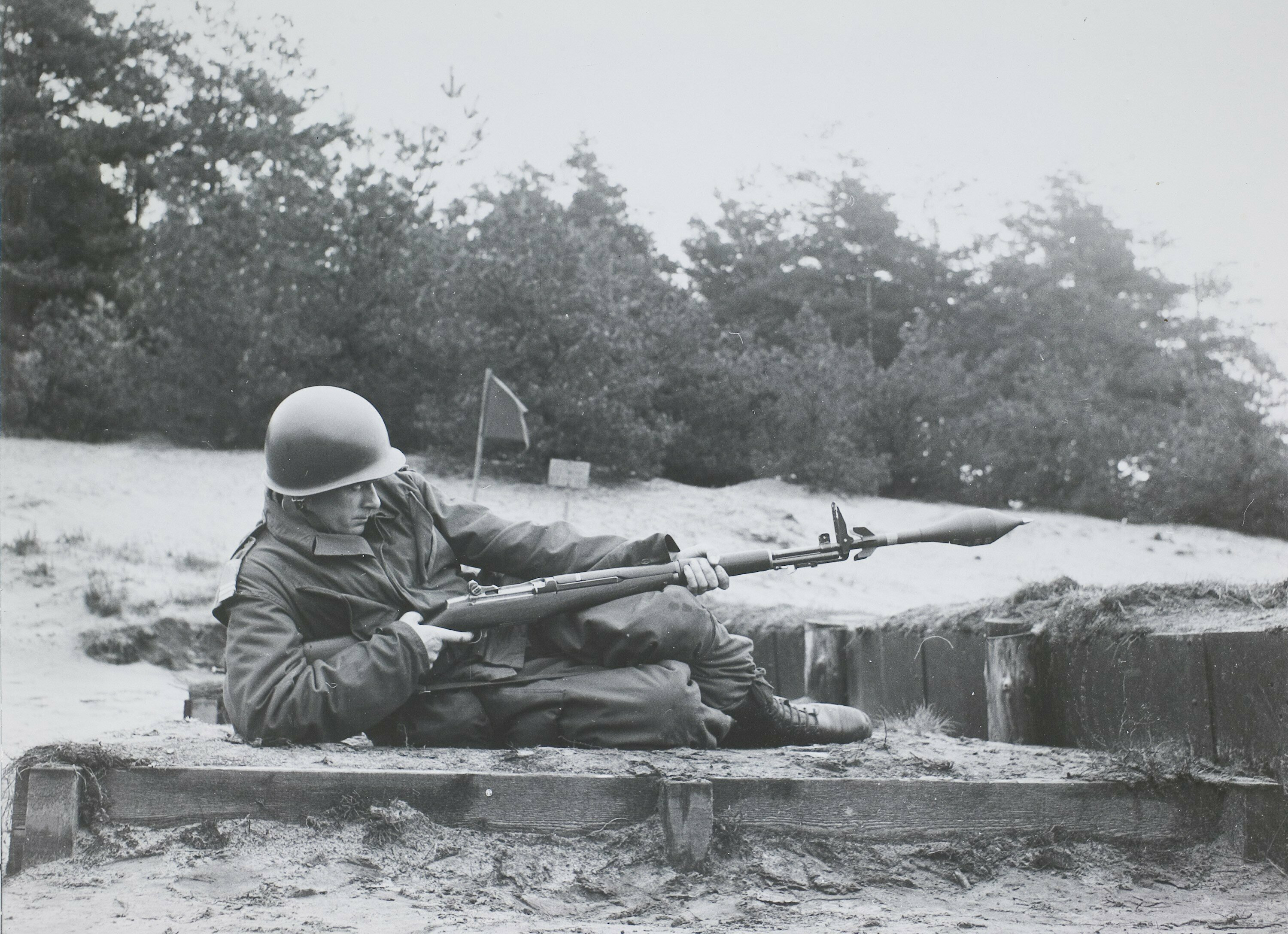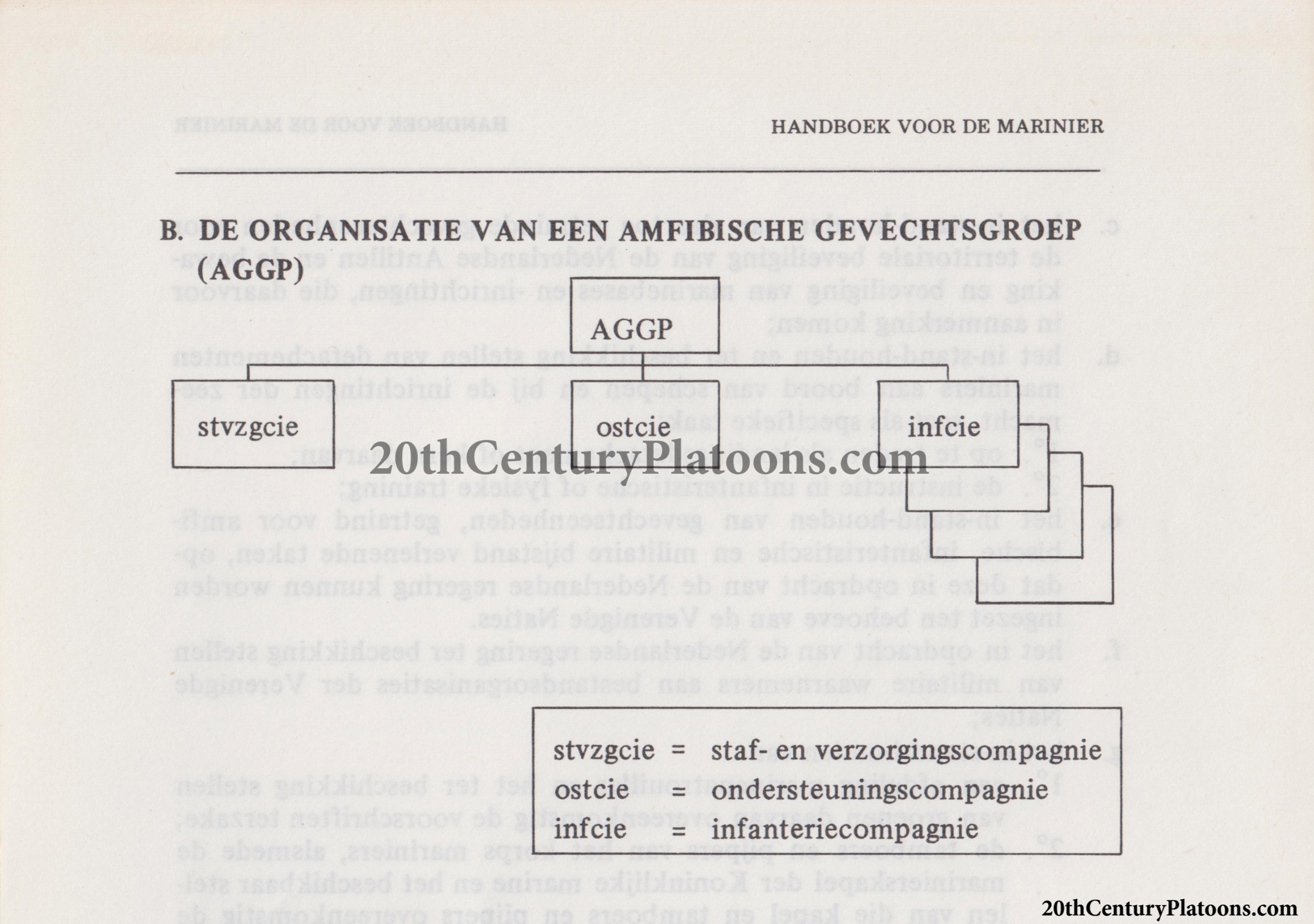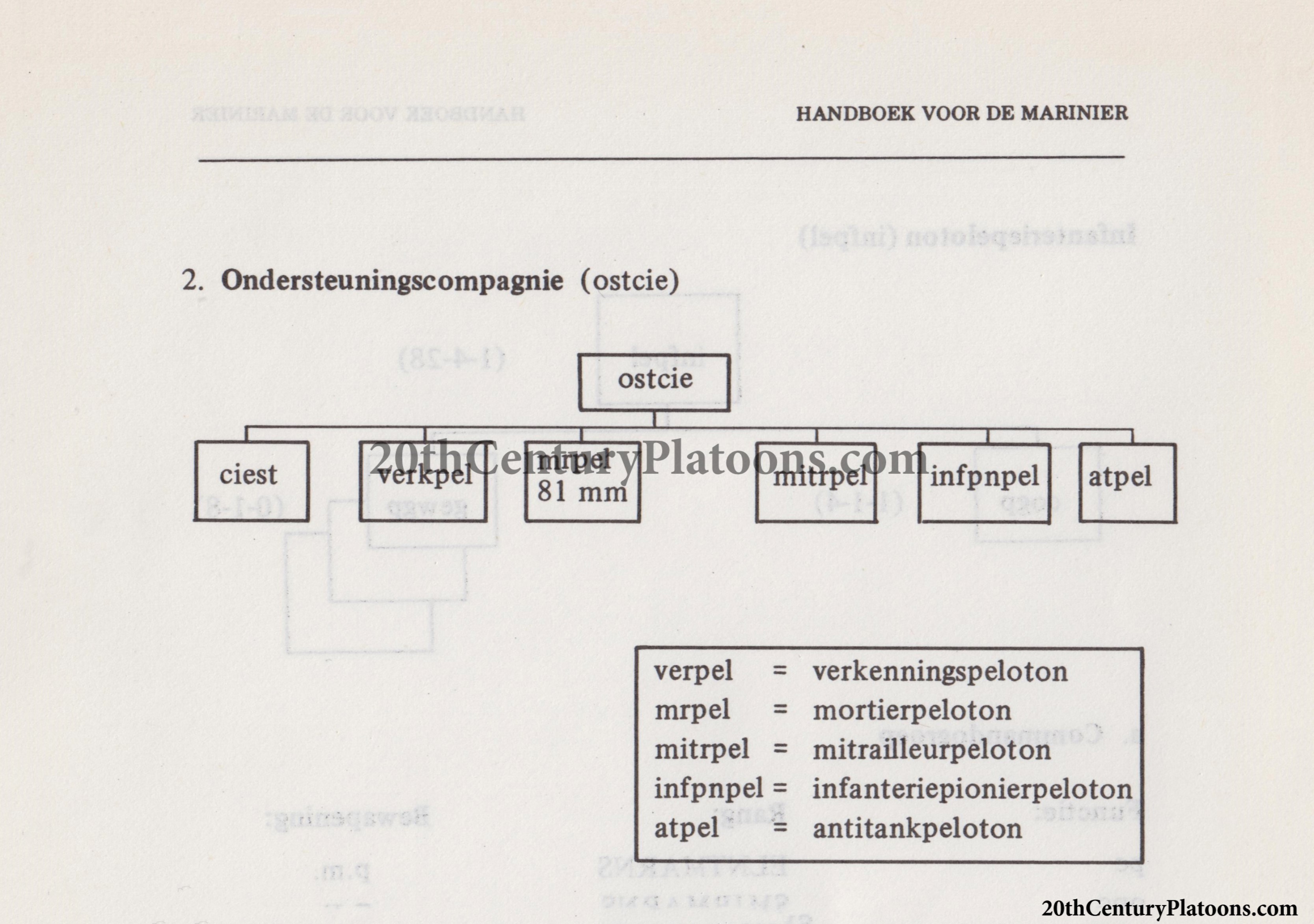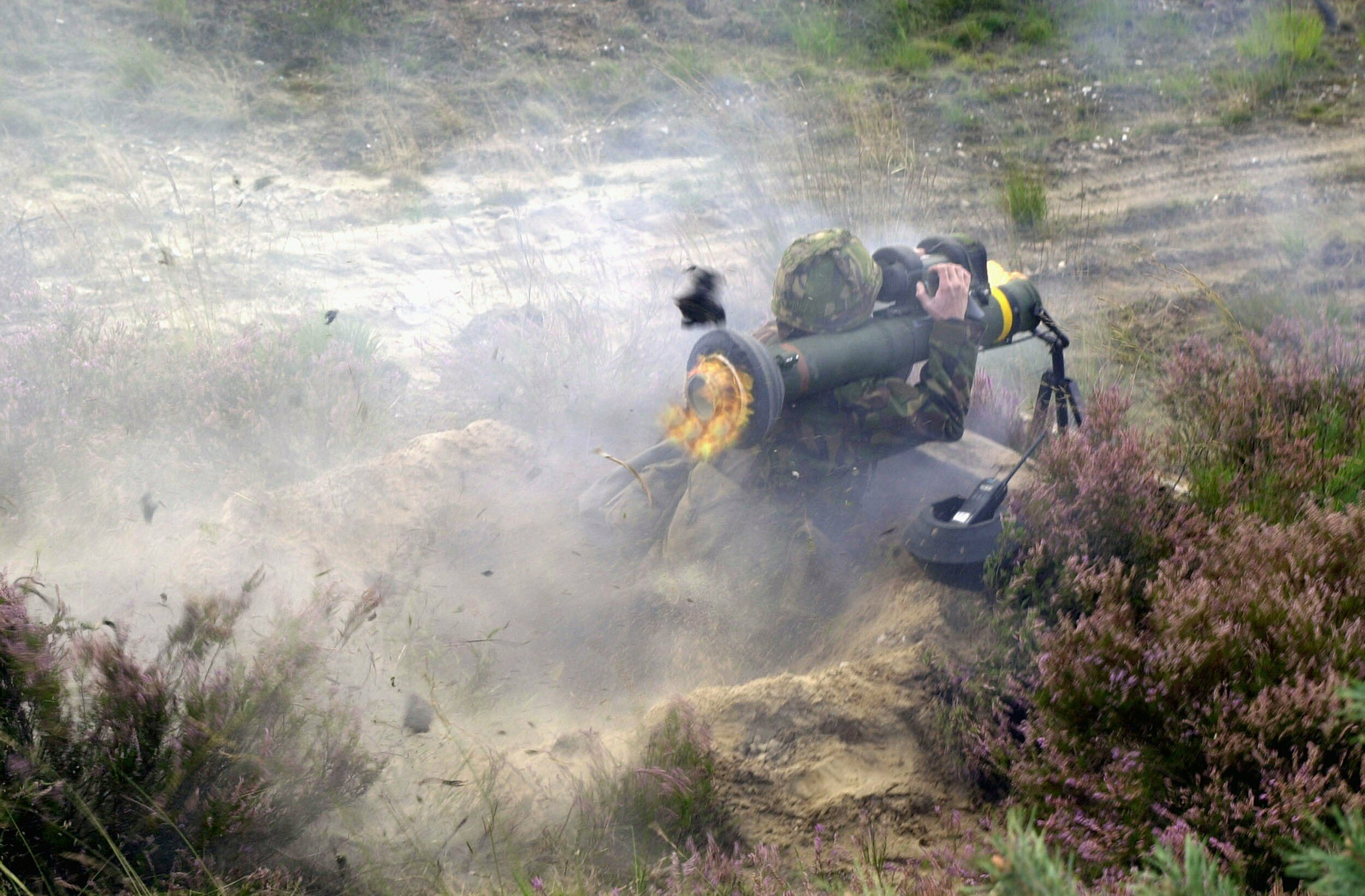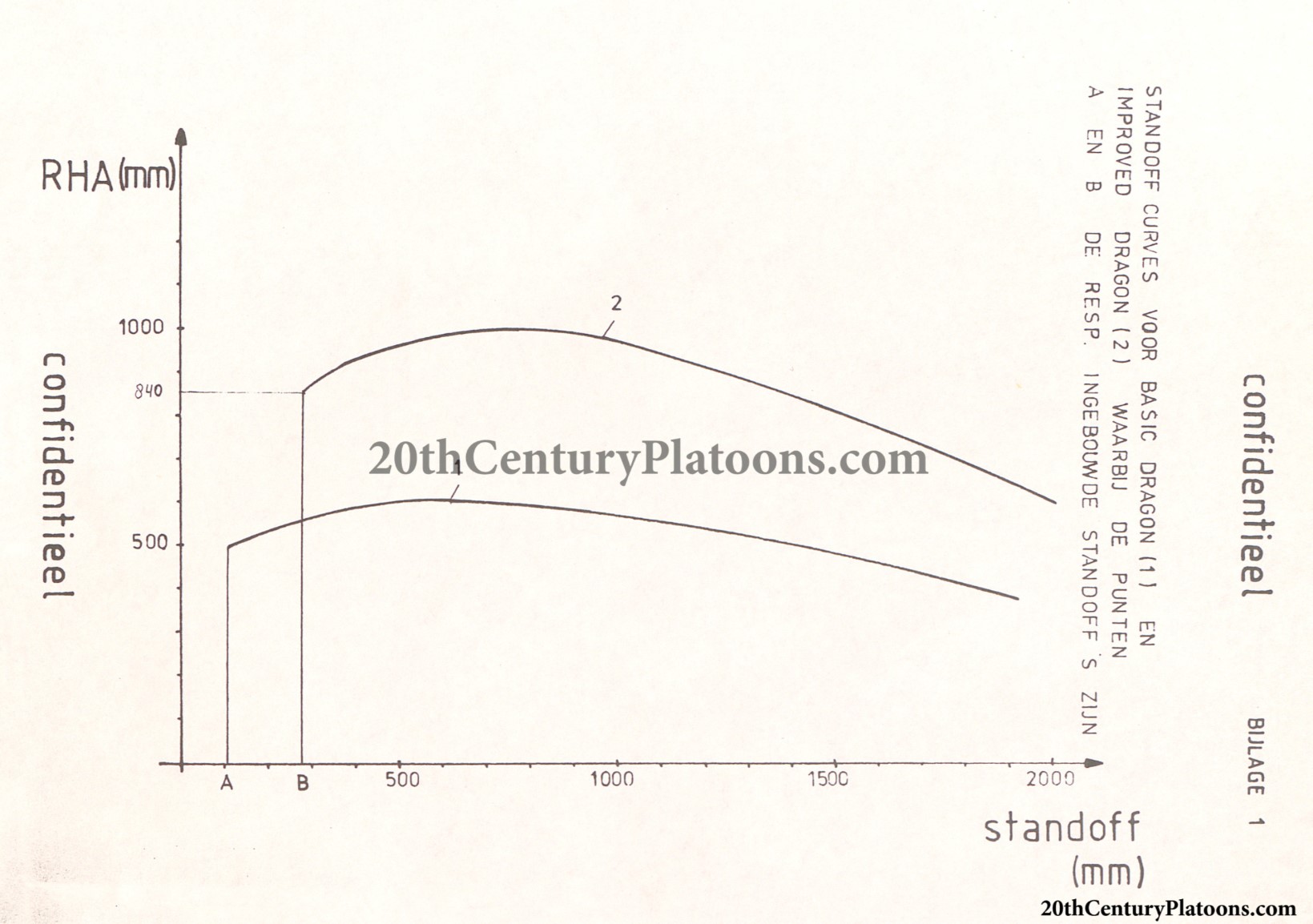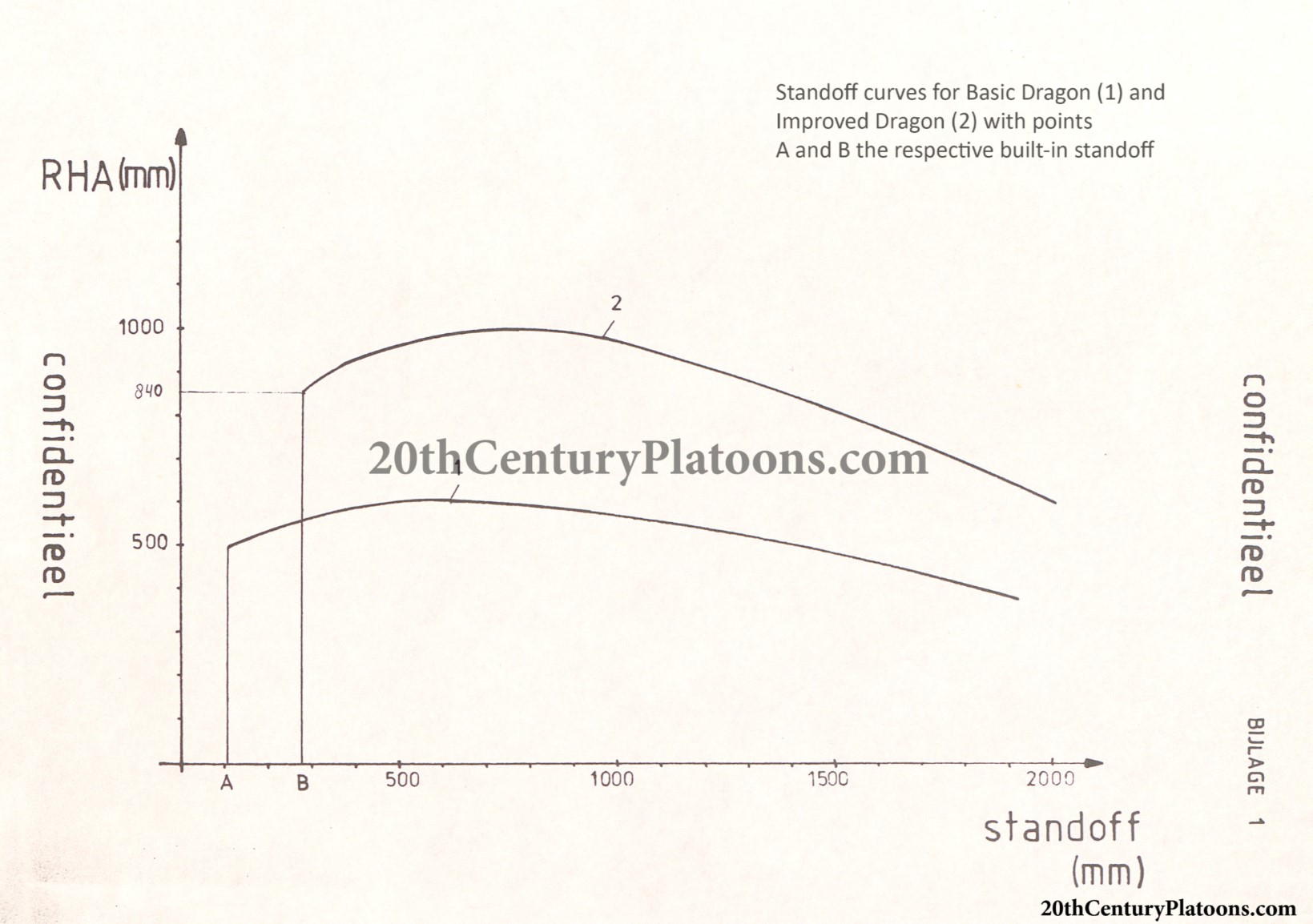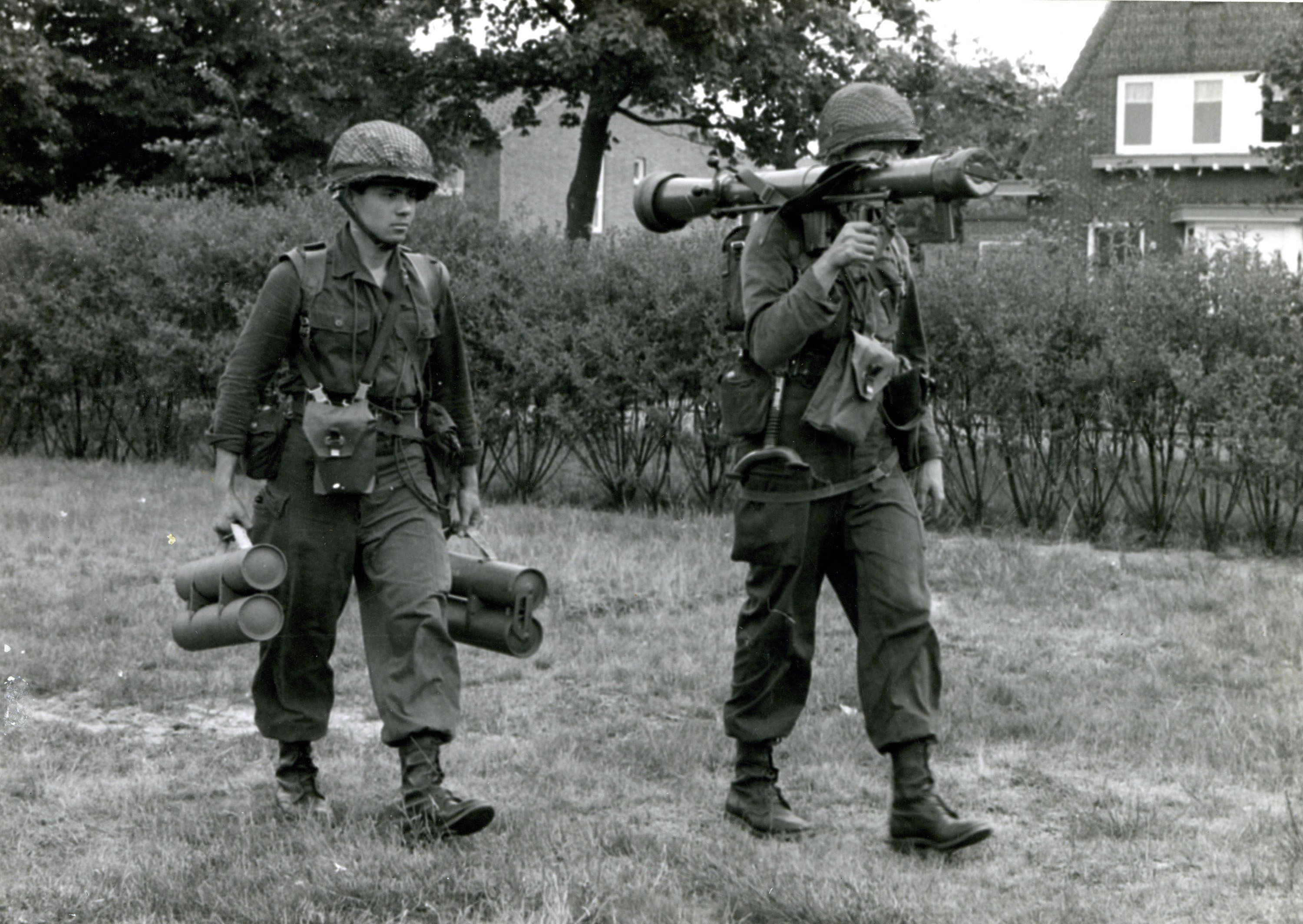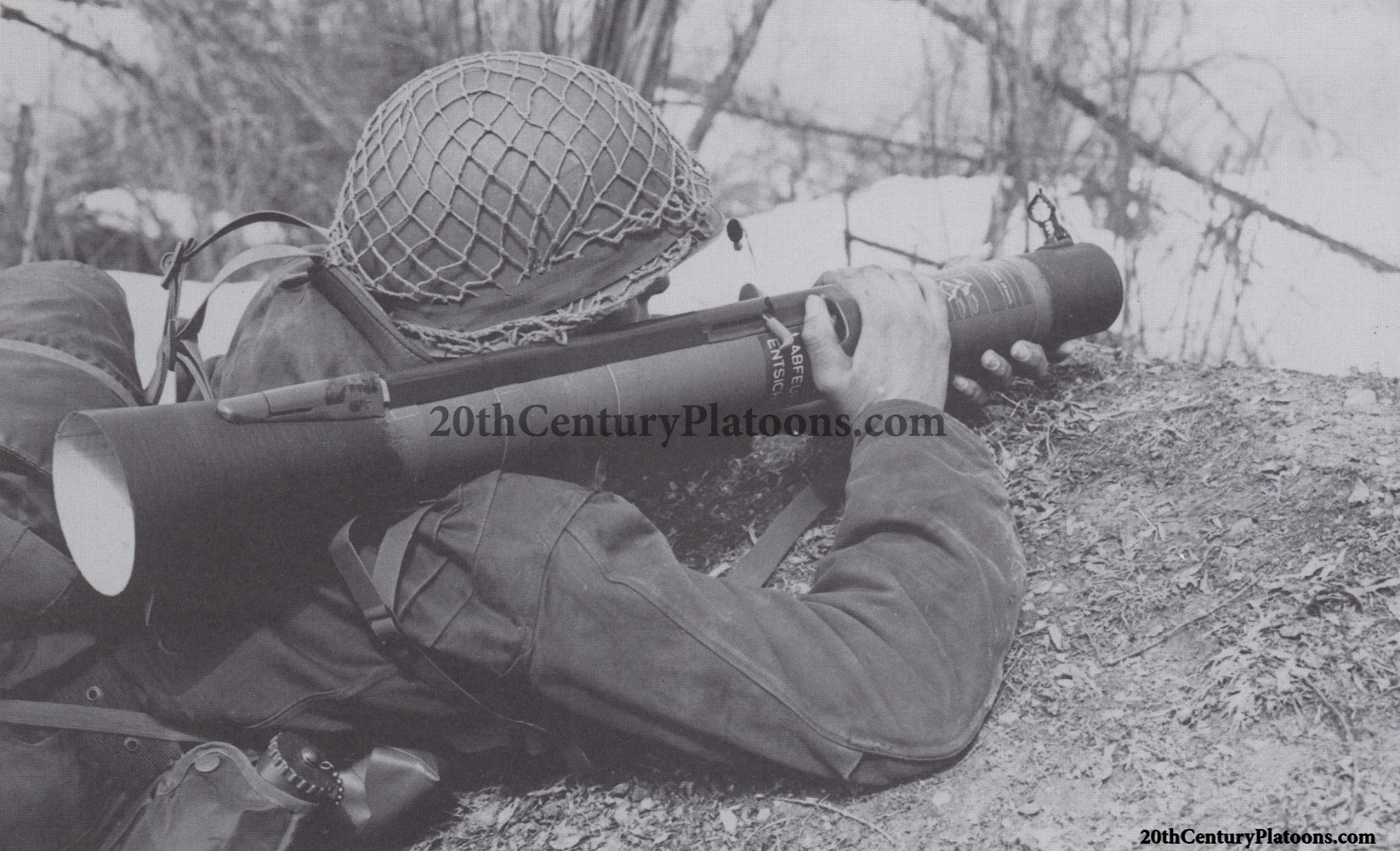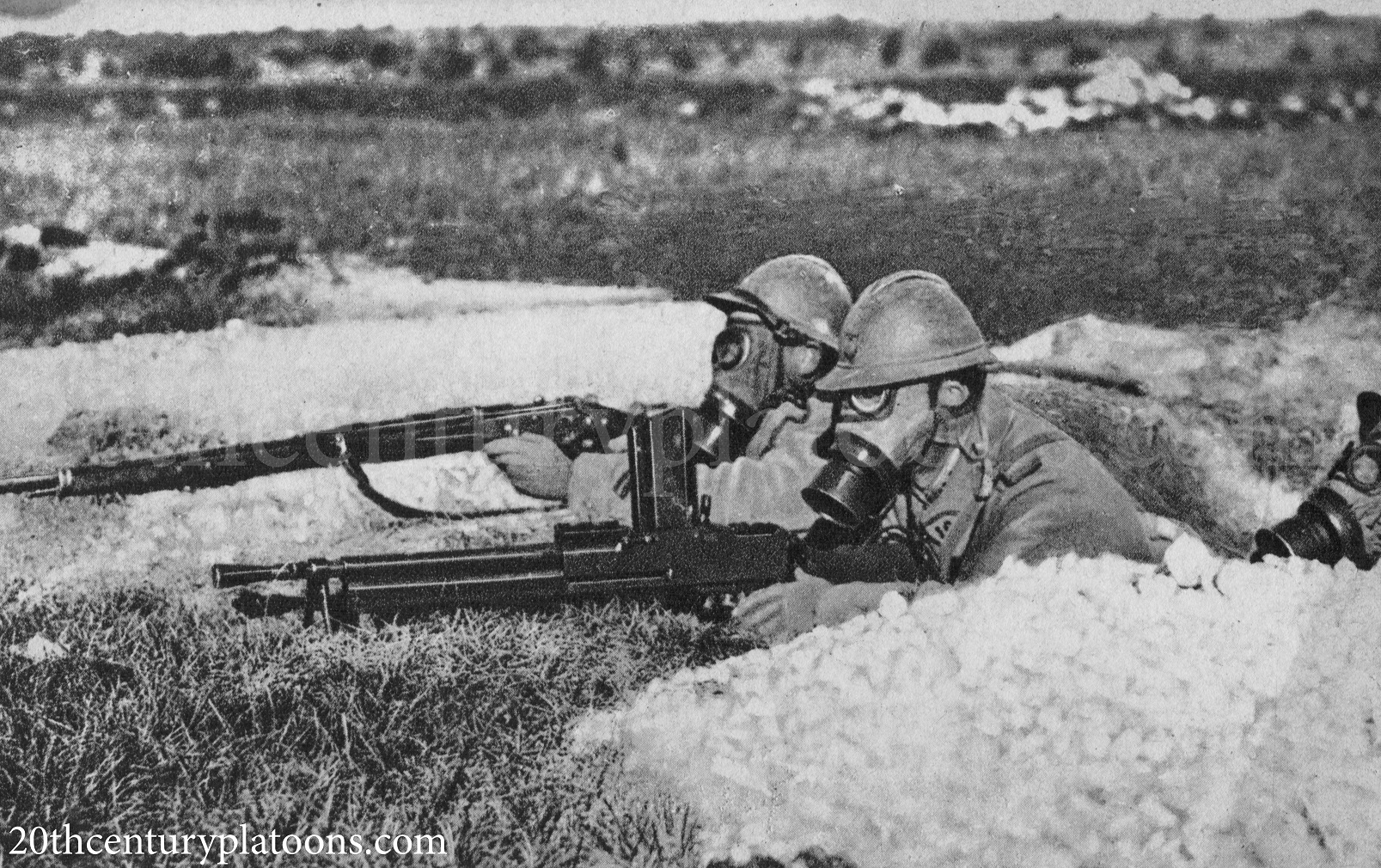×
![]()
The standard for Western GPMGs, the FN MAG is used by over eighty nations, amongst which of course its home country, Belgium.
Initially developed to accept both FAL magazines and belted ammunition (American M13 or West-German DM1 type),
the weapon modified and combined the barrel and bolt mechanism of the FN Model D (a variant of the M1918 BAR) with the
trigger and feed mechanism of the MG42.
With the dual-feed capability dropped, the weapon was eventually offered to the Swedish and British militaries in 1957,
with both adopting the weapon in 1958
and 1961 respectively.
It would strongly appear the Belgians did not adopt the weapon until 1962, given the provisional nature of our document in question.
The FN MAG would initially be a weapon exclusive to the Para Commandos,
the airborne light infantry component of the Belgian Army, with one weapon scaled per platoon, fifteen per company, and 45 per battalion.
It would be with the Paras where the FN MAG would fire perhaps its first shots in anger,
during Operatie Rode Draak/Operation Dragon Rouge. The weapon was used in its infantry and tripod version, the latter from Jeeps.
As late as 1974, the weapon was entirely absent from the mechanised infantry battalions mounted on the AMX APC,
the battalion being equipped with a mix of 68 FN FALOs, 32 FN .30-cals, 55 American .30-cals,
nine Browning .50-cals, and four M45 quadmounts instead.
Somewhat later in 1981, the FN MAG had finally been introduced to line units, with a mechanised infantry platoon possessing
two rifle squads equipped with one FN MAG each, in addition to their two FN FALOs.
The M75 "Full-tracks" still were still somewhat awkwardly equipped with .30-cals.
Below, the weapon's technical specifications are translated and the parts list is shown in full. The entire manual is available
here.
The archive of manuals can be found here.
A final note on the weapon's name: MAG stands for Mitrailleuse À Gaz, not Mitrailleuse d'Appui Général,
as evidenced from various early documentation
. The weapon was, however, marketed as the GPMG in English language publications,
a term which has most likely been incorrectly translated back into French. FN's Dutch-language publications used the far more neutral Mitrailleur , designating it simply as a "machine gun".
| Technical Characteristics |
| Calibre |
7.62×51mm NATO |
| Weight of weapon, with buttstock and bipod |
10.85 kg |
23.9 lbs
|
| Weight of weapon, without buttstock and bipod |
10.1 kg |
22.3 lbs
|
| Weight of the barrel (with gas regulator, flash-hider, and carrying handle) |
2.75 kg |
6.1 lbs
|
| Overall length, with flash-hider |
1255 mm |
49.4 in
|
| Barrel length |
545 mm |
21.5 in
|
| Sight radius (folded down) |
848 mm |
33.4 in
|
| Sight radius (extended) |
785 mm |
30.9 in
|
| Rifling, number of grooves |
4 |
| Rifling, twist rate |
305 mm |
1 in 12" |
| Sight, graduated in 100 m increments, folded down |
200 to 800 m |
| Sight, graduated in 100 m increments, extended |
800 to 1800 m |
| Weight of the tripod |
12 kg |
26.5 lbs |
| Traverse |
| On bipod |
50 degrees |
880 mils |
| On tripod |
67 degrees |
1200 mils |
| Elevation |
| On tripod |
30 degrees |
530 mils |
Footnotes
×
![]()
Today's post further explores the Diemaco down to its details, with the detaillijst showing us all parts down the 3rd echelon.
The Diemaco family of weapons has previously been discussed here as follows:
Adopted in 1995, the Geweer, 5,56MM, C7 and C7A1 replaced the FN FAL and M61 Uzi, and to a lesser extent the M1 Garand and M1 Carbine in
use with territorial and reservist units. The C8 carbine and C7 LSW (termed
LOAW) replaced select FN Browning High-Power pistols, M1 carbines and M61 Uzis, and the FN FALO respectively.
The initial contract called for a total of 52,285 weapons to delivered, with the
Army receiving 39,500 C7s, the Airforce and Royal Marechaussee receiving 7,500 C8 carbines, and the Navy receiving
4,750 C7A1s and 535 LOAWs respectively, the latter for the Korps Mariniers.
This leaves out the C8A1 and C8A1GD (Geluidsdemper), which appear to be later modifications of the C8.
It was, however, not to be so. As the Army (and other services) downsized following the Cold War's end,
the number of rifles required was adjusted accordingly.
Even more so, the Army's initial plan of only adopting the iron-sighted C7 was quickly thrown out the window, with additional C7A1s being procured.
The choice of foregoing the scoped C7A1 was driven by the initial requirement for a rifle capable out to 300 metres,
as opposed to the Navy's (Korps Mariniers) requirement of 500 metres.
In the end, the Army procured C7 for its non-combat troops,
issuing the C7A1 to airmobile and mechanized infantry.
This also explains the chapter dedicated to the bayonet in the C7A1 manual, which is absent from the C7 manual.
In the future, the various posts on the Diemaco family of weapons
will be combined into a single, long-form post, including various editions of the field manuals (VS 7-508 1995; 1996; 2003;2007).
The full manual can be downloaded
here, with the individual pages showing the drawings available below.
The archive of manuals can be found here.








Footnotes
×
![]()
Perhaps one of the most successful post-war tanks, the Centurion served with a variety of countries, including the Netherlands.
Although initially expecting to use the American M47 tank, it was decided in 1952 to equip the Dutch Army with the Centurion instead,
as the American tank was required by its home country due to the Korean War.
With an agreement reached by the end of 1952, the United States placed an order in the United Kingdom for 435 Centurion Mk. 3 tanks,
to be delivered under the Mutual Defence Assistance Program. Ultimately, 592 tanks would arrive starting from January 12th 1953 to 1956,
with one example lost to a fire in the summer of 1953.
Upon arrival, the Mk. 3 tanks were quickly modified to the Mk. 5 standard,
which included replacing the BESA machine gun with an M191914A4 and replacing the British WS No. 19 radio with an American SRC 508 or 528, among other changes.
Somewhat curiously, the document posted below has some notes on anti-tank warfare,
describing the use of Molotov cocktails and how to disable tracks.
Appropriate for the time, the notes also discuss the Soviet T34-85, T-54/55, T-44, PT-76, and IS-1/2/3 and T-10 tanks.
The drawings can be downloaded here.
The archive of manuals can be found here.












Footnotes

×
![]()
For today's post, we have two spare parts lists for the Swedish 7,62 mm automatkarbin 4, the Heckler & Koch G3, and the
8,4 cm Granatgevär m/48B and m/48C, the 84mm Carl Gustaf.
The G3 has a fair few accessories, such as a bayonet, cleaning kit, .22 conversion kit, and Hensoldt 4×24 scope.
The Carl Gustaf is a weapon worth expanding on in terms of the organisation surrounding it.
With a Skyttepluton
consisting of an HQ element,
three Skyttegrupper
and a Granatgevärsgrupp
,
the latter was equipped with two launchers, and organised as such
:
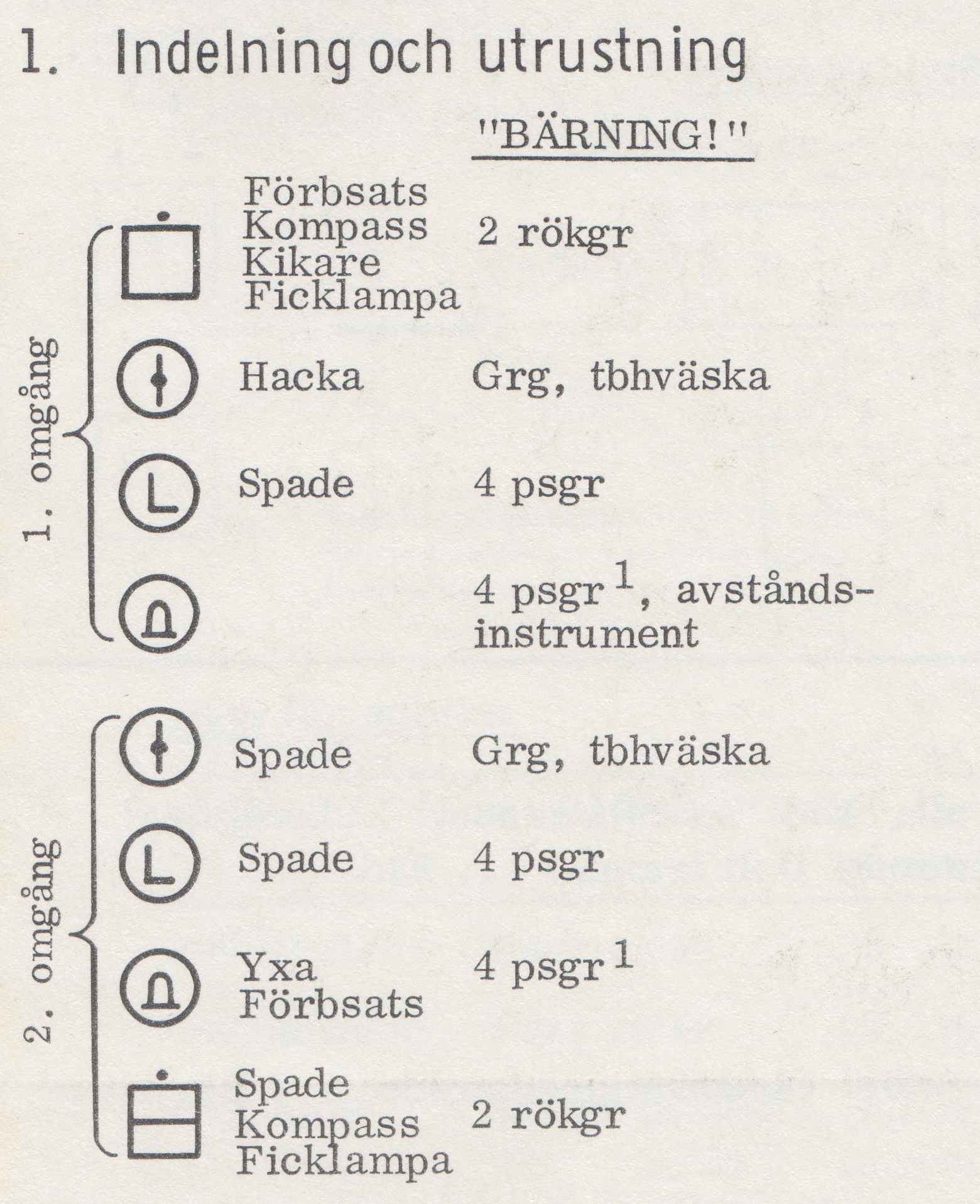
| 1st Carl Gustaf |
Squad leader
|
First aid kit
Compass
Binoculars
Flashlight |
2 smoke rounds
|
Gunner
|
Pick
|
Carl Gustaf
Tool kit |
| Loader |
Shovel |
4 AT rounds |
Ammunition bearer
|
|
4 AT rounds
Range-finding tool |
| 2nd Carl Gustaf |
Gunner
|
Shovel
|
Carl Gustaf
Tool kit |
| Loader |
Shovel |
4 AT rounds |
Ammunition bearer
|
Axe
First aid kit |
4 AT rounds
|
Deputy squad leader
|
Shovel
Compass
Flashlight |
2 smoke rounds
|
The G3 parts list is available here,
with the Carl Gustaf parts list available at the link here.
Footnotes
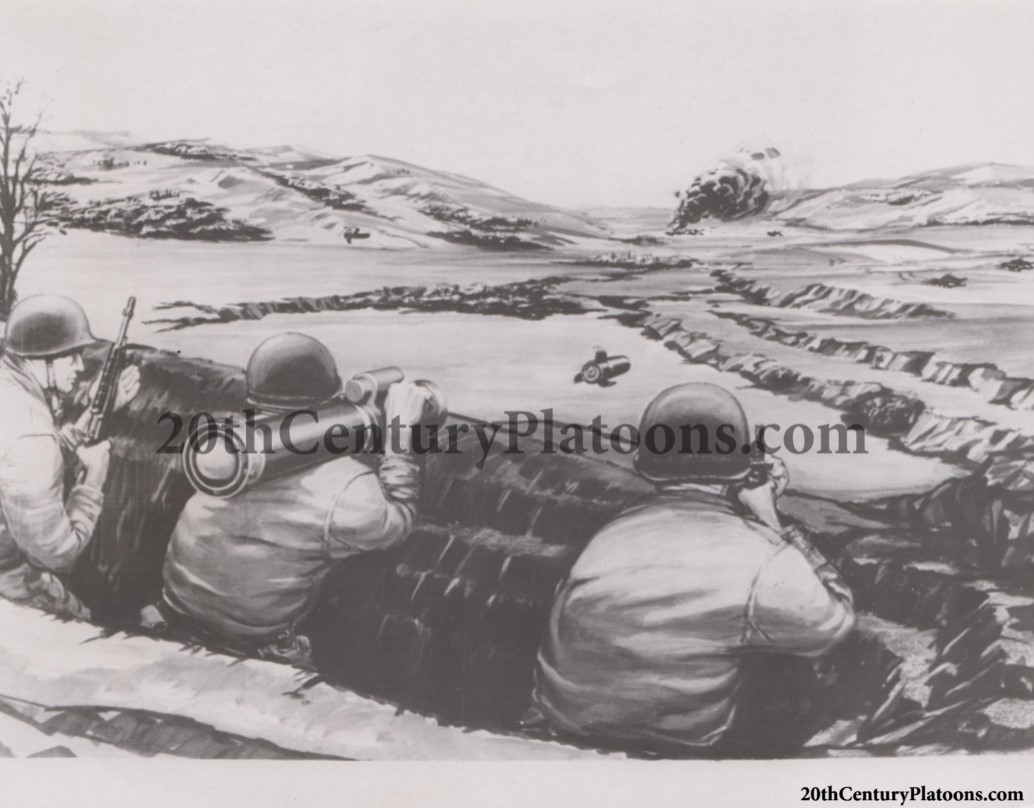
×
![]()
Introduction
In the 1960s, the Dutch Army found itself
undergoing a fundamental transformation: the process of mechanisation and motorisation was initiated for the 1st and 4th Division:
the infanteristen (infantrymen) would
become pantserinfanteristen (armoured infantrymen; mechanized infantry), equipped to fight on the mechanized battlefield.
Facing the mighty tanks and capable BMPs of Warsaw Pact, modern anti-tank weapons were more than required.
Although the Carl Gustav was selected in 1962 to replace the 57mm M18 recoilless rifle and 3.5in M20 Bazooka used at the
infantry platoon level
, the Dutch Army would seek to improve the infantry platoon’s antitank capability as early as 1968, just two years after deliveries of the new weapon began.
A number of issues were noted with both the Gustav itself, and the scale of issue:
The Gustav is, due to its weight and required ammunition, limited by the carrying capacity of its two-man team. It is thus less mobile and as a result more vulnerable. Successful use of the weapon must therefore be sought in its rate of fire, the amount of ammunition present with the weapon, and the use of multiple guns in the same sector. As opening fire at the maximum range will betray the firer’s position, positions must be changed often so as to escape the enemy’s return fire. The initial salvo of multiple weapons in the same sector affords the greatest opportunities, after which fire will be less effective as the enemy concentrates its fire on our antitank weapons. Moving to an alternate firing position will take time. Leaving the initial firing position by foot to move to the alternate firing positions will increase the Gustav team’s vulnerability. A minimum of two weapons in the same sector is therefore necessary to ensure continuous fire at a range of 500 m.
It is however interesting to note the current allocation of the Carl Gustav and
their ammunition across the different echelons. As noted, the current allocation of two
Carl Gustavs to the infantry platoon is regarded as inadequate with regards to ensuring continuous fire.
The two Carl Gustavs assigned to the company headquarters are regarded as being
of little use, as they will be assigned to those platoons that find themselves up front.
Creating main points of effort [Zwaartepunten, Schwerpunkte] at the company level is regarded as a
doubtfully useful practice. The amount of ammunition carried by the Gustav teams is insufficient,
and will require riflemen to bring up ammunition to the firing position. The timely presence of ammunition
is of key importance. It is not unthinkable only a small percentage of the necessary ammunition can be
brought up to the Gustav.
All of this pleads for more Gustavs and more ammunition at the platoon level.
As the poor ratio of available troops to the frontage to be
covered will necessitate strongpoints, the maximum range Gustav’s
maximum range of 500 m must be regarded as insufficient. The company is
forced to enter into combat at close range with a considerably stronger foe, with all the odds favouring the enemy.
Below, the solution to the above problem is described, in the form of a set of requirements put forth on the 1st of July,
1969, as well as an information brochure for
the XM47 Dragon Weapon System, unsurprisingly found accompanying the requirements document. Indeed, it can be argued the requirements are
solely aimed at adopting the Dragon, which happened a decade later in 1978.
The Dragon would however, not quite match the requirements, as illustrated in the table below.
| |
Requirement/
Desired Feature |
Additional Requirement/
Feature |
M47 Dragon |
| Weight, loaded |
<10kg |
14kg |
| Weight, loaded, with night sight |
<15kg |
20.7kg |
| Length, transport |
<1.50m |
1.15m |
| Length, ready-to-fire |
<1.20m |
| Height, in firing position |
<0.60m |
0.96-1.29m |
| Ammunition, max weight, in tactical container |
<5.5kg |
<3.5kg |
10.9kg |
| Range |
750 metres |
1000 metres |
1000 metres |
| Incapacitation probability |
90% at 750 metres |
90% at 1000 metres |
- |
| Rate of fire |
At least 5 rounds per minute |
2-3 rounds per minute |
| Projectile type |
Guided
or
Unguided, with tracer |
Guided |
| Sight |
Optical Sight
or
Open Sights
or
Range-Finding Sights |
Optical sight, 6× |
Click here to continue reading.
Footnotes
×
![]()
As is commonly known by those interested in small arms, 5.56×45mm NATO was standardized upon in 1980 following trials involving a
number of cartridges, and variations of 5.56×45mm.
During said trials, Belgium, France, Germany, the United Kingdom, the United States and
the Netherlands submitted a number of rifles and light machine guns as well, although no weapon was standardised across NATO:
| Country |
Cartridge |
Rifle |
Machine Gun |
Note |
| Belgium |
7.62×51mm NATO SS77 |
|
MAG-58 |
Control LMG (7.62mm) |
| 5.56×45mm SS92 |
|
|
|
| 5.56×45mm SS109 |
FNC |
MINIMI |
|
| France |
5.56×45mm M193 |
FA-MAS |
|
|
| Germany |
7.62×51mm NATO |
G3 |
MG3e |
Control rifle (7.62) |
| 4.7x21mm, caseless |
G11 |
|
|
| United Kingdom |
4.85x49mm |
XL64E5 |
|
right hand ejection |
| XL68E2 |
|
left hand ejection |
| |
XL65E4 |
right hand ejection |
| |
XL69E1 |
left hand ejection |
| United States |
5.56×45mm M193 |
M16A1 |
|
Control rifle (5.56) |
| 5.56×45mm XM777/XM778 |
|
|
|
| 5.56×45mm XM855 (SS109 equivalent) |
|
|
|
| The Netherlands |
5.56×45mm (M193) |
MN1 |
|
|
It is this last entry which will be the focus of this article, as it is sometimes incorrectly identified as a Stoner 63.
Click here to continue reading.
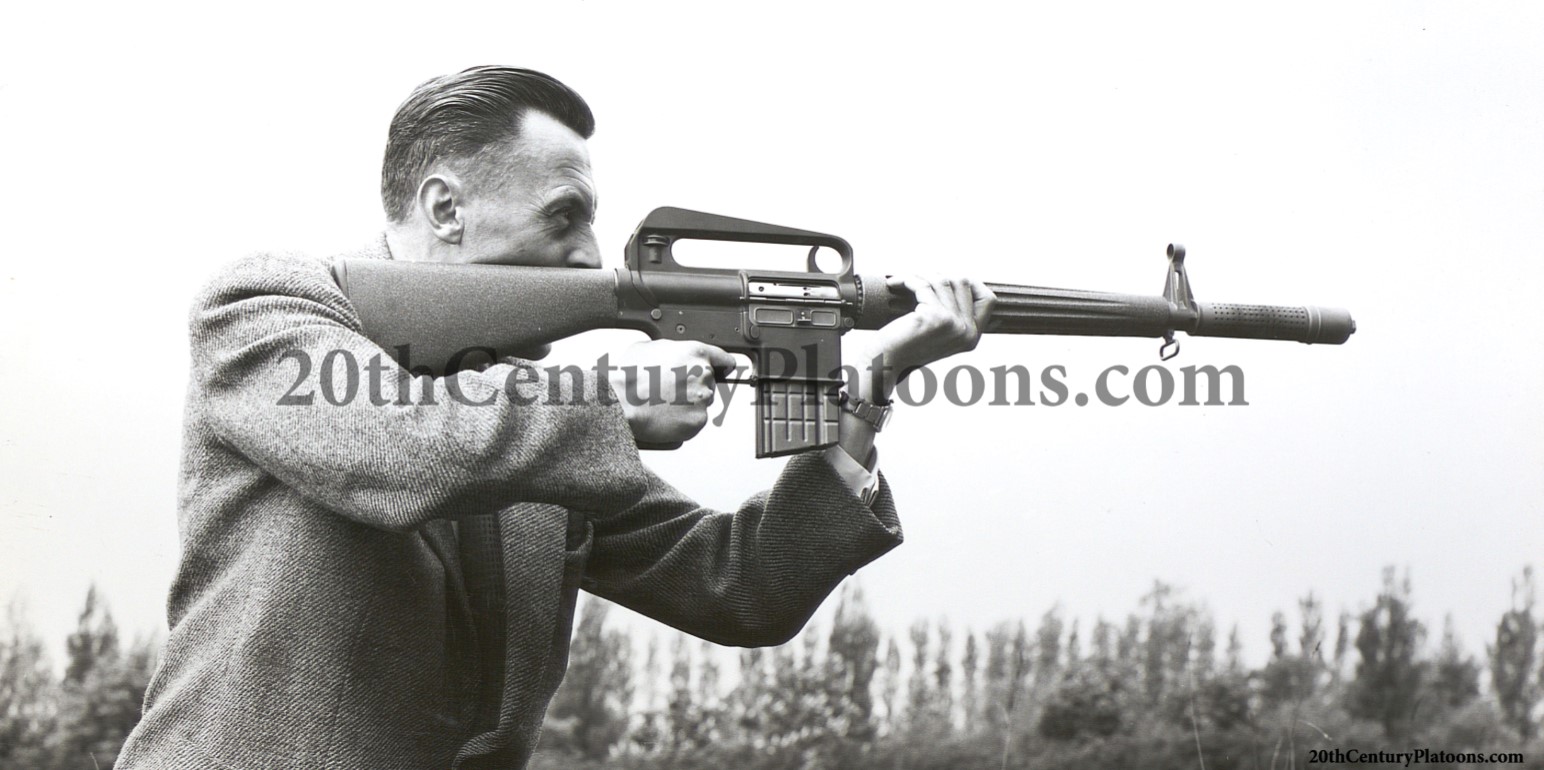
×
![]()
The following is a report concerning a demonstration of the AR-10 on the 21st of May, 1957 at Waalsdorp.
It can be accessed at the Nationaal Archief in Den Haag (The Hague) under the index
Nationaal Archief, Den Haag, Korps Mariniers, nummer toegang 2.13.141, inventarisnummer 96: De proefnemingen met het Armalite AR-10 geweer, 1957.
The images here are sourced from the same set of documents, though they are not necessarily images of the exact trial gun(s) at the described demonstration.
Click here to continue reading.

×
![]()
As previously discussed here,
it was not uncommon during the Cold War for nations to produce manuals concerning the opposing force, be it NATO or Warsaw Pact.
In this post a Belgian document discussing the Warsaw Pact armies is presented.
Although the entire document makes for interesting reading, for the sake of brevity, only a small portion of the Belgian (French/Dutch) terminology is
translated below, specifically for the squad through the company level as found on pages 2-2 to 2-5.
It should, of course, be noted that this document by no means contains any particularly insightful information as to exactly what
the Warsaw Pact militaries looked like, rather, it informs us how the Belgians perceived the Warsaw Pact forces.
The manual can be downloaded here.
The archive of manuals can be found here.
| French |
Dutch |
English |
|
| Page 2-2 |
|
| Section de Fusiliers Motorisées sur BMP |
Gemotoriseerde Fusiliersectie op BMP |
Motorised Rifle Squad/Section mounted in a BMP |
| Chef sec |
Sec Comd |
Squad/Section Leader |
| Mi |
Machine Gunner |
| Fusiliers |
Riflemen |
| Tireur ATK |
ATK Schutter |
Anti-Tank Gunner |
| Chef Veh |
Vtg Comd |
Vehicle Commander |
| Canonnier |
Kanonnier |
Gunner |
| Chauffeur |
Driver |
|
| Page 2-3 and 2-4 |
|
| Peloton de Fusiliers Motorisées sur BMP |
Gemotoriseerd Fusilierpeloton op BMP |
Motorised Rifle Platoon mounted in a BMP |
| Chef Pl |
Pl Comd |
Platoon Commander |
| Tireur Elite |
Scherpschutter |
Designated Marksman |
| Tireur |
Schutter |
(Machine) Gunner |
| Tireur AA |
AA Schutter |
AA (MANPAD) Gunner |
|
| Page 2-5 |
|
| Compagnie de Fusiliers Motorisées sur BMP |
Gemotoriseerde Fusiliercompagnie op BMP |
Motorised Rifle Platoon mounted in a BMP |
| Comd Cie |
Cie Comd |
Company Commander |
| Offr Adj |
Executive Officer |
| SOffr Techn |
Techn OOffr |
Technical Non-Commissioned Officer |
| SOffr Cie |
Cie Ooffr |
First Sergeant |
| Radio |
Radio Operator |

×
![]()
The équipement à intensification de lumière D.I.P.T. 9 set is composed of a
lunette de tir de nuit OB 25 scope, lens cover, two spare nickel-cadmium batteries,
three mounting brackets for the FR F-1, AA-52, and LRAC 89mm respectively, two spare lamps, and a screwdriver.
For carrying in the field and transport, a pouch and case are available. The pouch itself carries the OB-25 scope, lens cover, and the two spare batteries.
Click here to continue reading.
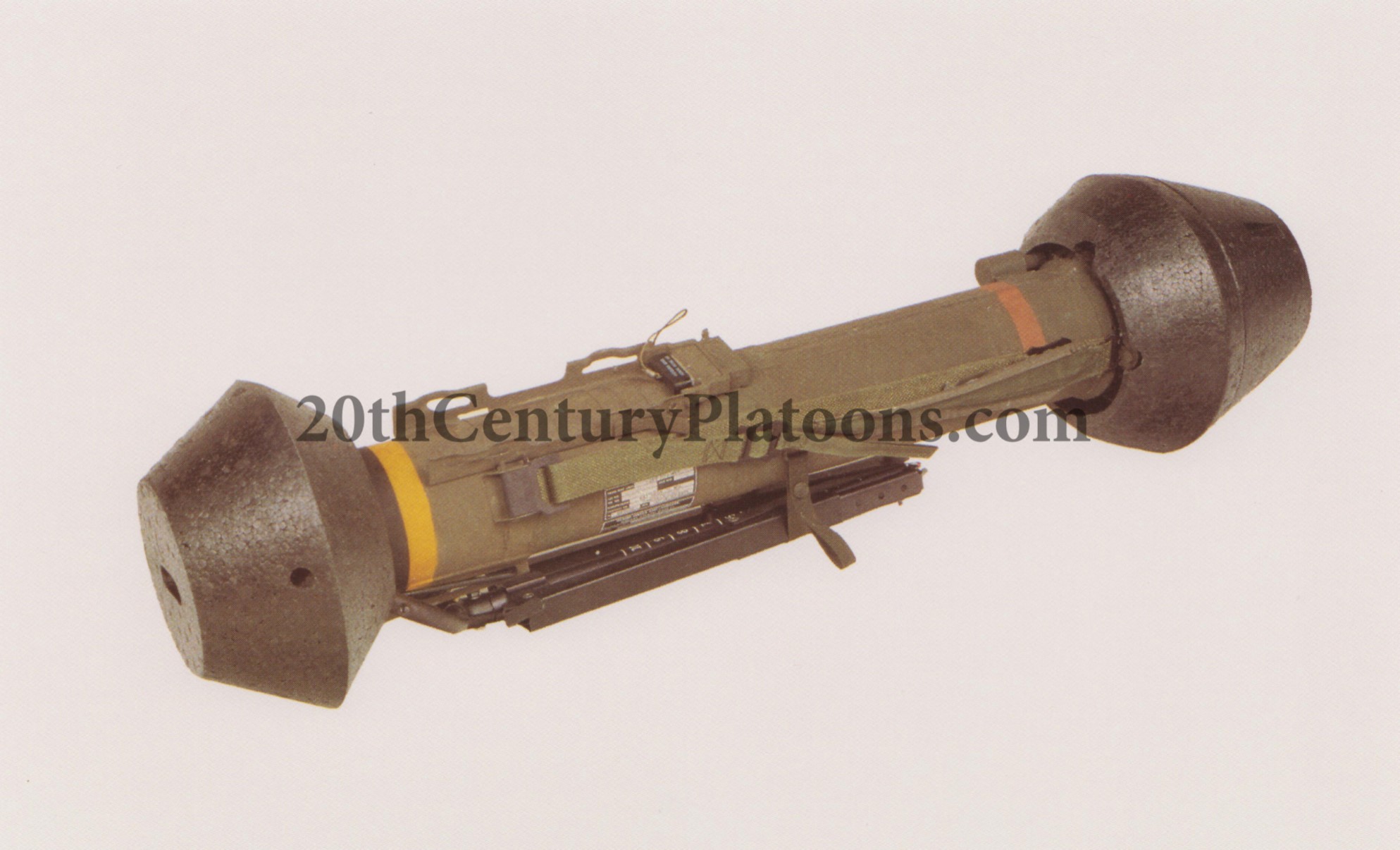
×
![]()
How do we stop the ever-improving fleet of Soviet and Warsaw Pact tanks? Such a question was on the mind of Dutch military planners, especially with regards to finding the right mix of anti-tank weapons.
The following is a discussion of the M47 Dragon and MILAN anti-tank weapons, as found in archival documents dated October of 1977.
Although the Dragon is often derided in American literature on the topic,
the following document provides a more nuanced view and gives insight into the specific characteristics of both the M47 Dragon and MILAN, with the M47 Dragon eventually winning out.
Situation report
Medium Range Anti-tank Weapon System
1. Introduction
The Soviet Union has expanded her tank force by approximately 40% during the past decades. The units of the Warsaw Pact receive approximately 2000 new T-72 tanks every year, which boast high quality armour.
Engaging enemy tanks in combat will in case of an eventual conflict – as far as 1 (NL) Corps is concerned – occur by means of specific anti-tank weapon systems, potentially in combination with artificial obstacles
such as amongst other, mine fields.
2. Anti-Tank Philosophy
It is assumed within 1 (NL) Corps that anti-tank combat must commence at the greatest possible range, but must be continued at shorter ranges. After all, as range decreases, more tanks will expose themselves more often and for longer periods of time, among other reasons as there will be less cover.
In such a case, more anti-tank weapons will have to be deployed as the situation demands: this is called “intensification”.
This anti-tank philosophy demands – with respect to tactical necessity, technical characteristics and the cost factor – a so-called “mix” of anti-tank weapon systems possessing short, medium, and long range. A number of characteristics of these systems are noted in the table below.
Click here to continue reading.

×
![]()
As described in a previous post, the Dutch Army had been issuing the FN Browning High Power since 1946.
Still satisfying the operational requirements, it was decided as early as 1989
to replace the Browning (across the entire military) for economic and technical reasons: spare parts specific to the Dutch model(s) were difficult to acquire, leading to non-standard and more expensive parts,
as well as certain safety and logistical issues.
In August of 1991, four potential replacements were trialled at the Infanterie Schietkamp in Harskamp, being shot by male and female soldiers, both right and left-handed, in different types of uniform and equipment.
Those four pistols were the Beretta 92FS, Glock 17, SIG 226, and Walther P88.
Click here to continue reading.

×
![]()
The Grenade à Fusil antichar de 58 mm avec piège à balle modèle F1 is a French antitank rifle grenade designed in the late 70s, to be fired from the FAMAS F1 by using a standard ball cartridge.
Equipped with a bullet trap, this may be balle O (Ordinaire, ball) or T (Traçeuse, tracer), US M193 or FN SS92.
Click here to continue reading.

×
![]()
Adopted in 1946, the FN Browning High Power has been the longest-serving weapon
in the Dutch military in recent times, outlasting the M.95 Mannlicher by 3 years as a main service weapon.
Following an initial order of 10,000 pistols placed with
Inglis of Canada, further pistols were procurred from FN.
By 1967, some 72,000 High Power pistols were in use,
of five different varieties: John Inglis models, as well as 1947, 1949, 1955 and 1967 contract models.
Both the Inglis model (Pistool Browning Aanmaak Inglis Canada) as well
as the three earliest FN models (Pistool Browning Aanmaak F.N. België (oud model)) were collectively designated the
Pistool, 9 mm Browning, FN, GP, or more briefly, pistool oud model.
The 1967 contract pistols, designated Pistool, 9 mm, FN, GP, M68, were easily recognized by their external extractor.
As a complete issued item including magazine pouches, cleaning kit and holster
this led to four different "models" due to Marechaussee
specific equipment :
- Pistool, 9 millimeter: Browning, F.N., G.P., cpl (NSN 1005-17-640-0022)
- Pistool, 9 millimeter: Browning, F.N., G.P., M 68, cpl (NSN 1005-17-622-2426)
- Pistool, 9 millimeter: Browning, F.N., G.P., cpl v/Kon Marechaussee (NSN 1005-17-039-0292)
- Pistool, 9 millimeter: Browning, F.N., G.P., M 68, cpl v/Kon Marechaussee (NSN 1005-17-039-0293)
Although multiple editions of the Materieellijst (1996, 1997 and 2003) speak of a 1987 introduction date for the
Glock 17,
the FN Browning was only gradually replaced: first by the Marechaussee, which selected the Glock in May of 1990. Deliveries were however delayed,
as the other services sought a new handgun as well. By February of 1992, the Ministry of Defence had signed a contract for some 31250 Glock 17s for all services,
with an option for a further 7800 pistols. This latter option was quite possibly intended for the Royal Netherlands Air Force: it is noted that the
Air Force intended to keep its Browning High Powers somewhat longer.
As late as 1997, some FN pistols remained in inventory, intended for mobilisational units of the Army.
The technical manual can be downloaded here,
with the parts list available here.
The archive of manuals can be found here.
Footnotes
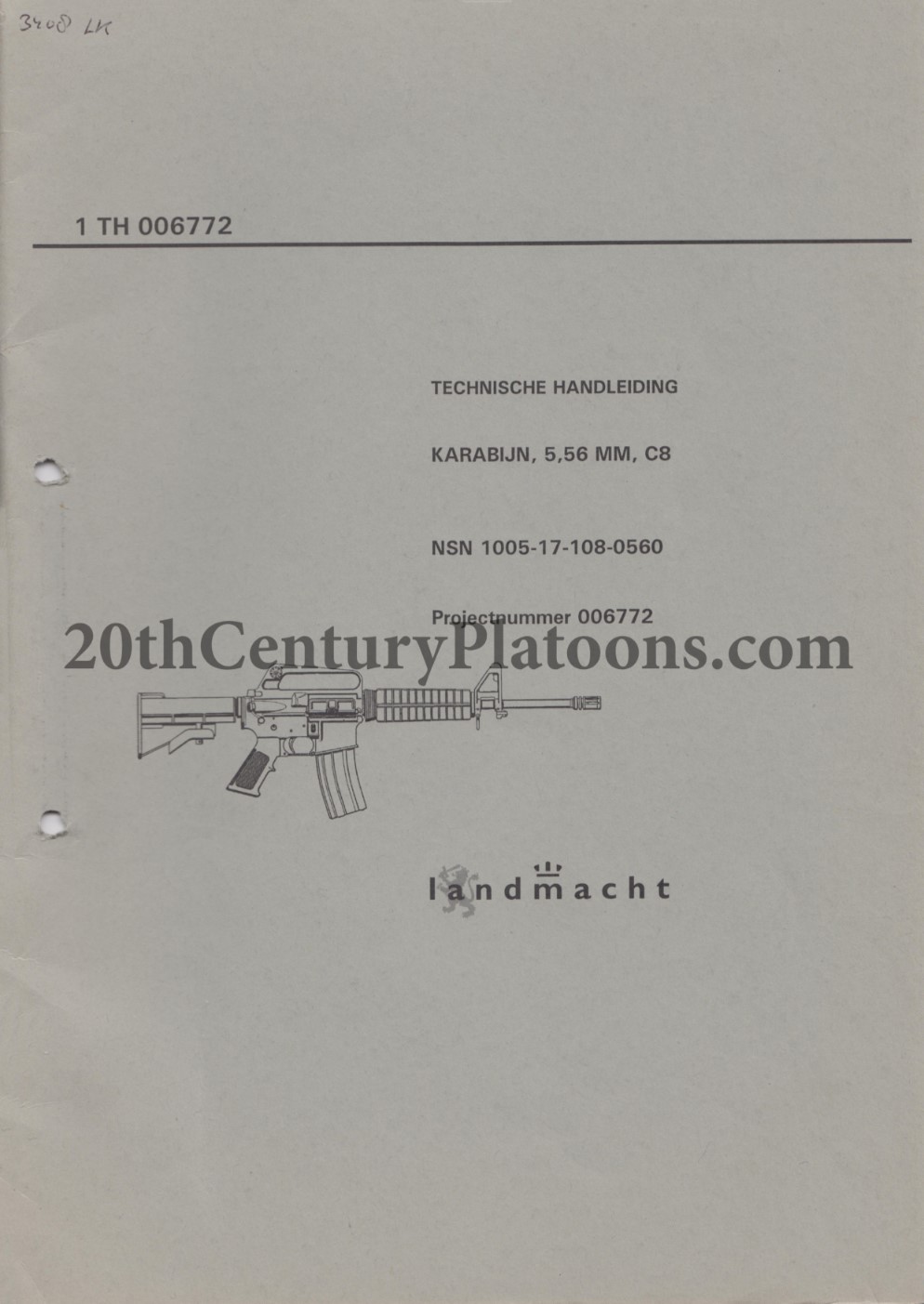
×
![]()
Following up on last week's post, we have a 1st echelon technical manual for the C8 carbine dated 1997.
One of three C8 carbine variants adopted (C8, C8A1, C8A1GD), the C8
was adopted to replace select FN Browning High-Power pistols, M1 carbines and M61 Uzis, especially for support troops.
A more thorough description of the Diemaco in Dutch service
can be found in the aforementioned post, with more technical
documentation and field manuals soon to be added to this website.
The C8 manual can be downloaded here
The archive of manuals can be found here.

×
![]()
Adopted in 1995, the Geweer, 5,56MM, C7 and C7A1 replaced the FN FAL and M61 Uzi, and to a lesser extent the M1 Garand and M1 Carbine in
use with territorial and reservist units. The C8 carbine and C7 LSW (termed
LOAW) replaced select FN Browning High-Power pistols, M1 carbines and M61 Uzis, and the FN FALO respectively.
The initial contract called for a total of 52,285 weapons to delivered, with the
Army receiving 39,500 C7s, the Airforce and Royal Marechaussee receiving 7,500 C8 carbines, and the Navy receiving
4,750 C7A1s and 535 LOAWs respectively, the latter for the Korps Mariniers.
This leaves out the C8A1 and C8A1GD (Geluidsdemper), which appears to be later modifications of the C8.
It was, however, not to be so. As the Army (and other services) downsized following the Cold War's end,
the number of rifles required was adjusted accordingly.
Even more so, the Army's initial plan of only adopting the iron-sighted C7 was quickly thrown out the window, with additional C7A1s being procured.
The choice of foregoing the scoped C7A1 was driven by the initial requirement for a rifle capable out to 300 metres,
as opposed to the Navy's (Korps Mariniers) requirement of 500 metres.
In the end, the Army procured C7 for its non-combat troops,
issuing the C7A1 to airmobile and mechanized infantry.
This also explains the chapter dedicated to the bayonet in the C7A1 manual, which is absent from the C7 manual.
The C7 manual can be downloaded here, with the C7A1 manual available here.
The archive of manuals can be found here.
Footnotes

×
![]()
The Lunette de Tir Modèle 1953 - designated the APX-L 806 by its manufacturer - was the French Army's scope for the MAS49 and 49/56 as
issued to the squad designated marksman. It was replaced in 1966 by the FR F1, a purpose-built marksman's rifle.
The French Army has had one of the most consistent marksman doctrines, issuing a single-scoped rifle per platoon in 1940 (typically a Lebel with APX 1921)
,
increasing the number of scoped rifles post-war to three.
Technical specifications are as follows:
| Magnification |
3.85× |
| Length without rubber eye-cup |
159 mm |
| Weight with mount |
500 g |
| Sight graduated in 50 m increments to |
800 m |
| Horizontal adjustment |
8 increments of 0.7 mills |
| Vertical adjustment |
14 increments of 0.5 mills |
The iron sights can be used out to 400 m with the scope mounted. The M1953 scope equipment also includes a cheek piece and two different sizes of rubber shoulder pads, increasing length of pull by 2 and 3.5 cm respectively.
The manual can be downloaded here.
The archive of manuals can be found here.
Footnotes

×
![]()
Adopted in 1961, the Dutch model FN FAL was only slightly modified during its 34 years of service as the
primary rifle of the Dutch Army. Starting off with metal handguards and a bipod, the former were replaced by polymer handguards, whilst the bipod was done away with.
The issues with the bipod have been documented by Ing. (Doctor of Engineering) R.L. Landzaat, former employee of Artillerie Inrichtingen:
as the bipods were not free-floated, they worsened accuracy considerably, something that had not gone unnoticed by instructors.
The manual can be downloaded here.
The archive of manuals can be found here.
Footnotes

×
![]()
Following the cancellation of the FA MAS 62 - a result of focussing on nuclear weapons and the need for modernizing the tank inventory
- the French Army was left with the need for both a more satisfactory marksman's rifle than the scoped MAS49/56, as well as the requirement for a competition rifle to replace the MAS 47.
These requirements eventually led to the Fusil à répétition calibre 7,5 mm modèle F1 - FR F1 for short - adopted as the Version A (marksman's rifle) and Version B (competition rifle) in 1966.
The manual can be downloaded here.
The archive of manuals can be found here.
Footnotes

×
![]()
Though certainly not the first pistol to employ a polymer frame - being preceded by the HK VP70 by twelve years - the Glock 17 is a pistol with an immense impact.
As the first order of Glock pistols were delivered in 1983, this is quite possibly the earliest military manual available for the plastic "wonder nine".
The manual can be downloaded here.
The archive of manuals can be found here.

×
![]()
As a follow-up to the recently posted FN Minimi manual, we have the Belgian Army's FN MAG manual from the same year, 2000.
As a bigger brother (tactically, not technically) to the Minimi, the MAG generally was issued out at a rate of one per platoon, though armoured infantry squads of the 1980s were known to have one per fusilier squad.
The manual can be downloaded here.
The archive of manuals can be found here.

×
![]()
Much like the American Army that adopted the FN Minimi as the M249 SAW, the Belgians used the
"Mini-Mitrailleuse" to arm each of their squad's two fireteams.
Later on, one of the Minimis was replaced by an FN MAG/ 7.62mm Minimi.
The Belgian Army is one that is surely to
be explored further in a following post, as some solid information is available concerning, for example, the adoption of the FN FAL.
The manual can be downloaded here.
The archive of manuals can be found here.
Footnotes

×
![]()
As was the case with so many other nations, the Belgian Armed Forces used the M72 LAW in the light anti-tank role.
Replacing the Energa rifle grenade, the M72 provides an easy-to-use option for dealing with any armoured vehicle
that is not a modern MBT.
It would appear the Belgians continue to use the M72 LAW, having upgraded from the A2 to the
EC version (AFAB VSR (Anti-Fortification Anti-Blindé Very Short Range)).
The manual can be downloaded here.
The archive of manuals can be found here.
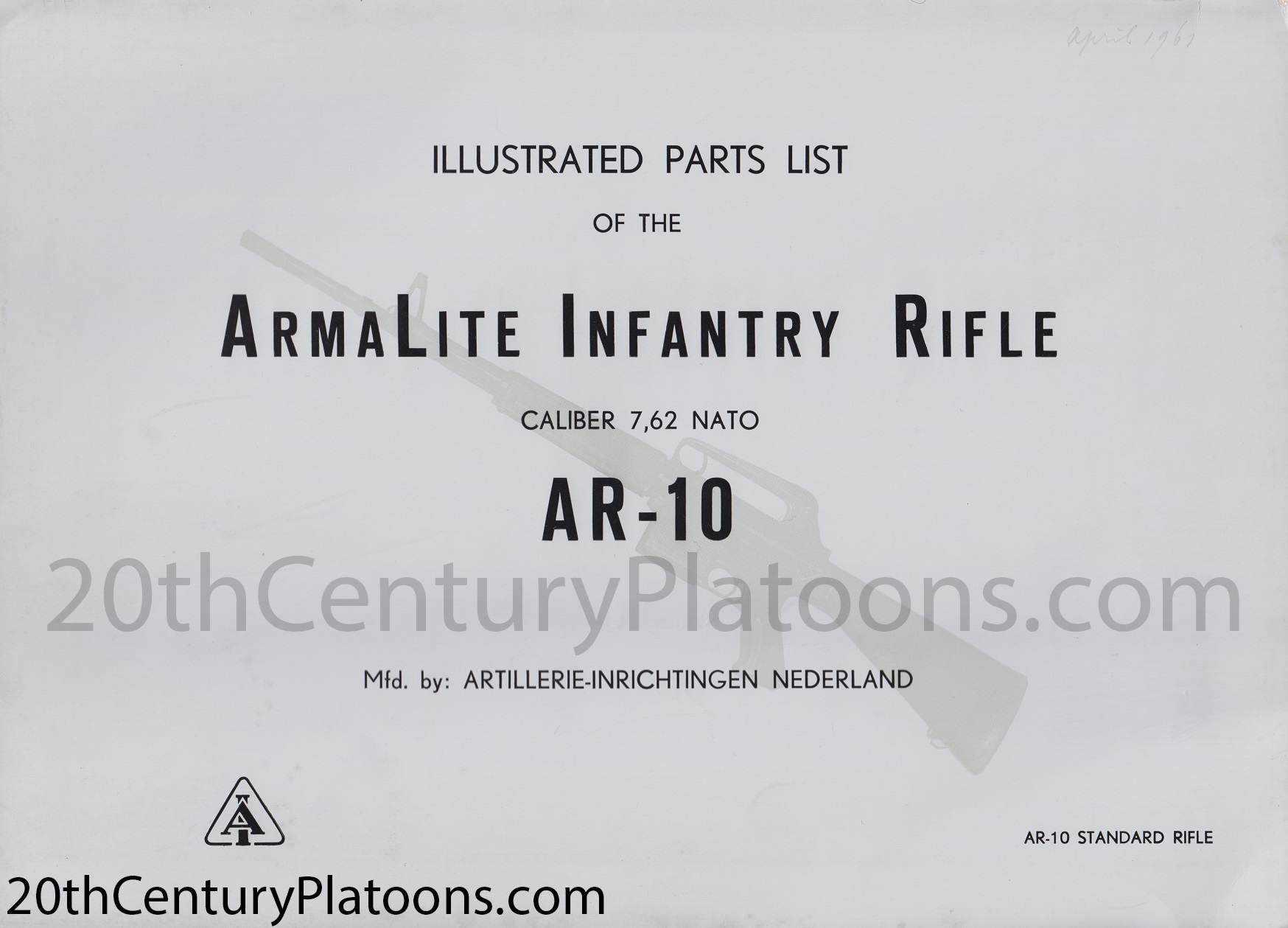
×
![]()
Without delving too deep into the history of the AR-10, Artillerie Inrichtingen had acquired the license to produce the "ArmaLite Infantry Rifle", producing small batches for a number of customers.
Though trialled by the Dutch military in 1961 - an event sure to be discussed at a later point - the rifle lost out to the FAL by quite a wide margin. The AR-10 simply was not as reliable. As such, state-owned AI would soon be shutting down production.
The following parts list is from right around this trial period, dated April 1961. It can be found in full here.
The archive of manuals can be found here.
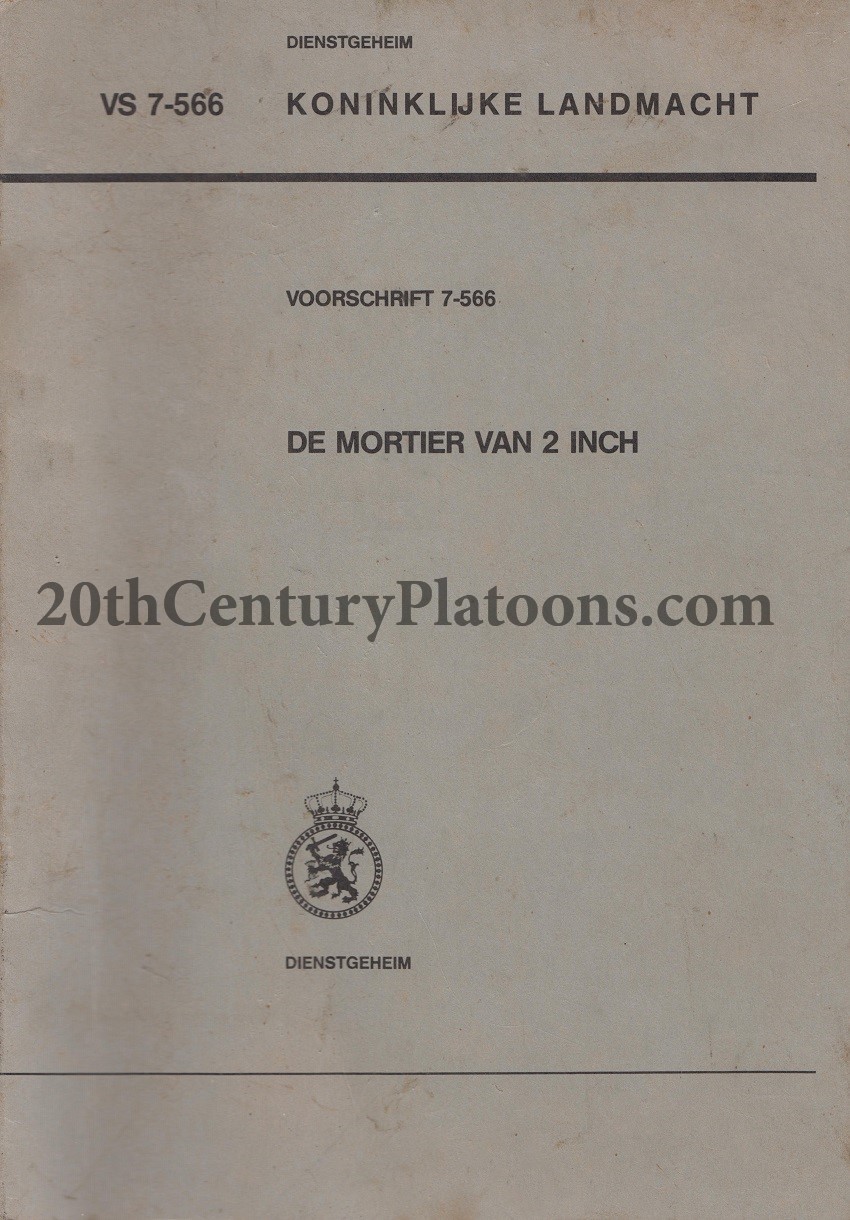
×
![]()
Following the defeat of the Dutch Army in 1940, a number of men escaped to the United Kingdom to continue the fight. These
Engelandvaarders would form the core of new Army, trained and equipped as if belonging to the British Army.
As such, the 2-inch mortar was taken into use, and would serve for another 48 years until replaced by the L9A1 51mm.
The entire manual - a brief 14 pages at its core - is found here.
The archive of manuals can be found here.
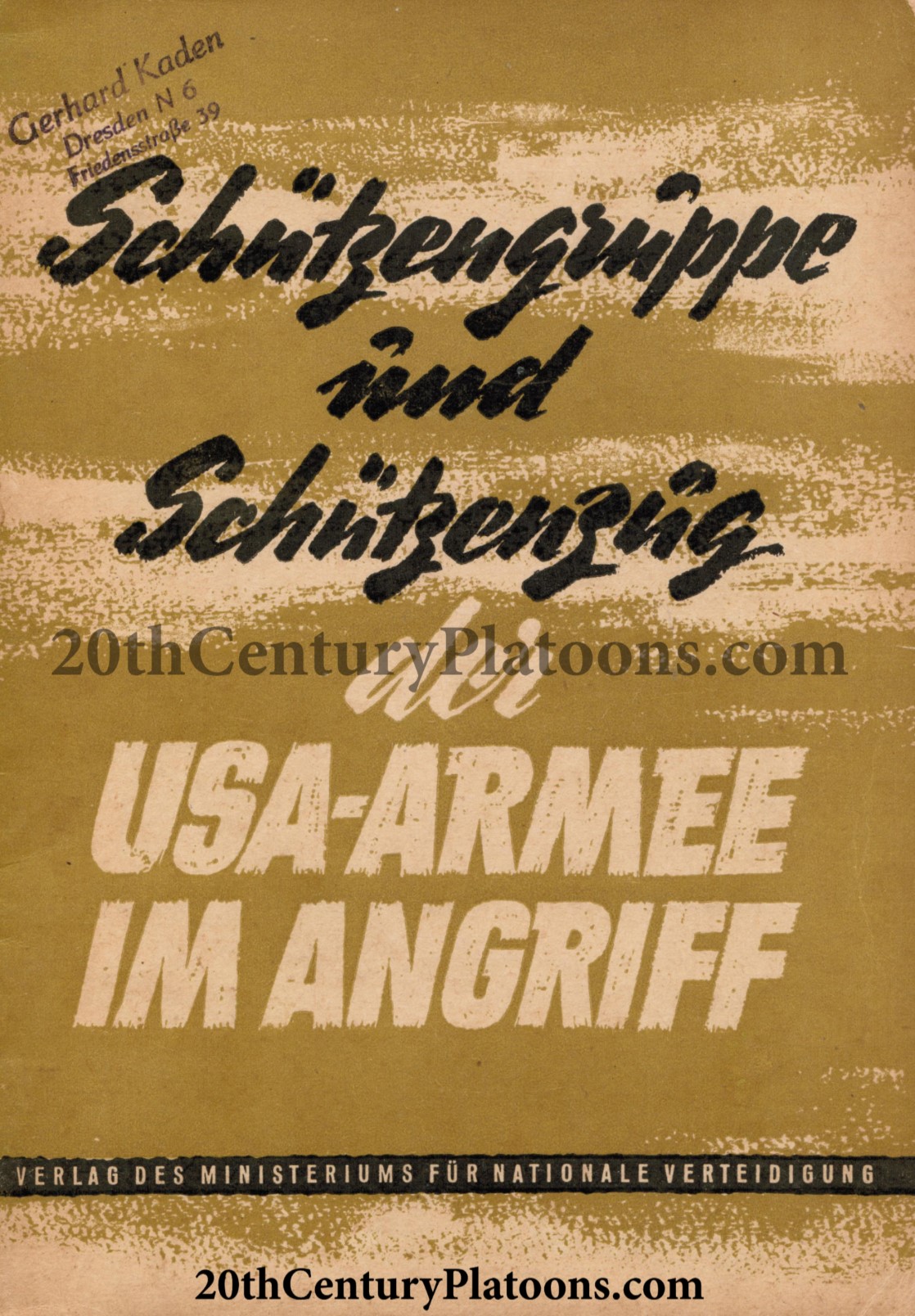
×
![]()
In the following post, we will take a look at an East German manual concerning
the US Army's rifle squad and rifle platoon.
This document, titled
Schützengruppe und Schützenzug der USA-Armee im Angriff
was published by the Verlag des Ministeriums für Nationale Verteidigung in 1956.
Click here to continue reading.
The manual is available for download here.
The archive of all manuals is available here.

×
![]()
Today, we have an FN operator's manual regarding the Mitrailleuse Minimi Calibre 5,56 × 45 mm NATO,
more commonly known as the FN Minimi.
Dated March of 1981, this provisional manual shows off the early Minimi, in addition to the Para and Tank (Char) models.
Below, the technical characteristics are presented and translated to US-customary units:
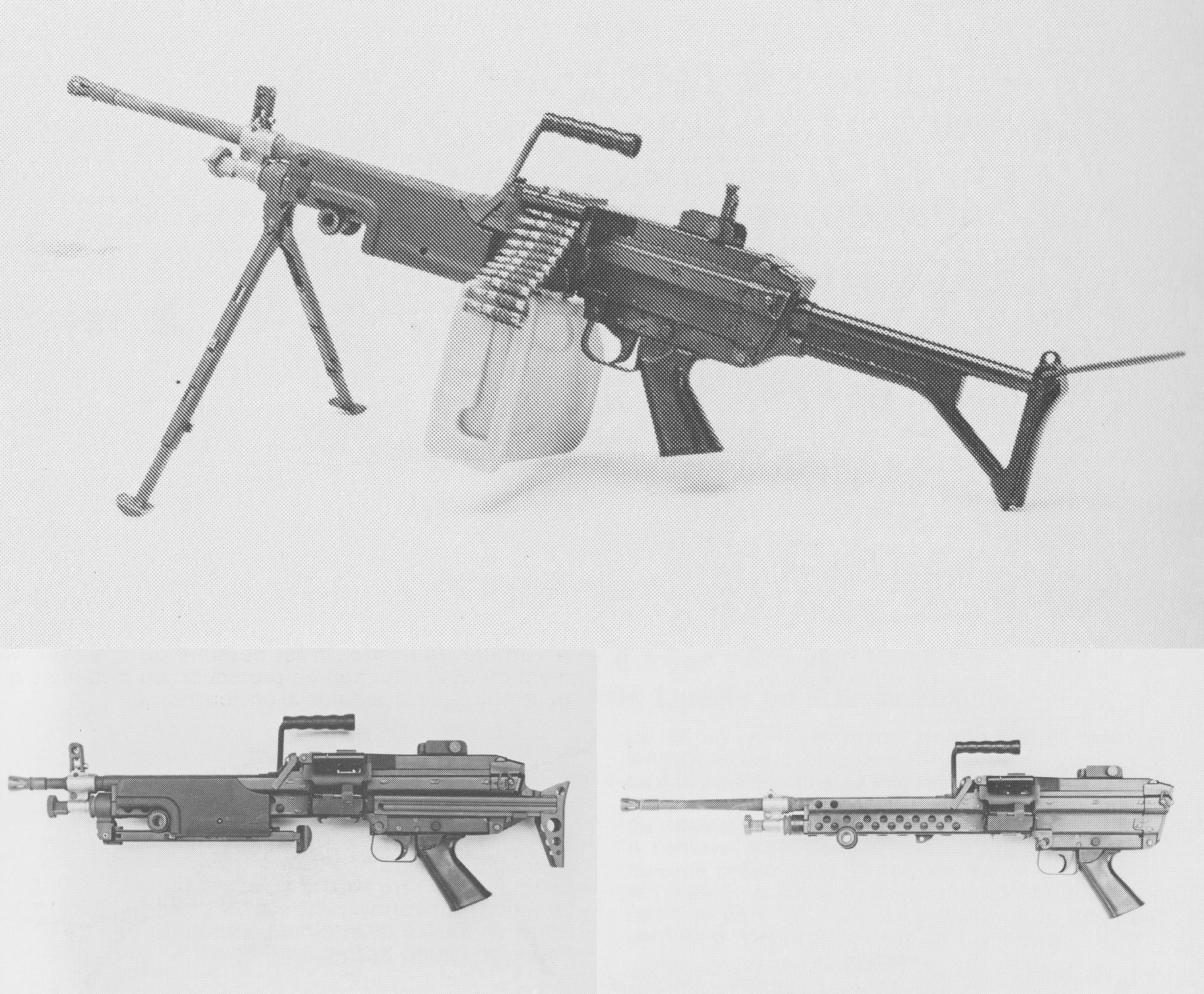
Click here to continue reading.
The manual is available for download here.
The archive of all manuals is available here.

×
![]()
For today, we have a British document to take a look at, a manual for the M20 3.5in Bazooka dated 1952.
Great-Britain entered World War II with the Boys Anti-Tank Rifle,
a .55 calibre weapon that was soon to find itself declared obsolete.
Even more so - as tank armour advanced - the anti-tank rifle was phased out in general in favour of shaped-charge weaponry.
In case of the British, this would come in the form of the PIAT, a rather awkward spigot mortar type weapon.
As early as 1950, the PIAT had been replaced by the American Bazooka.
Indeed, the Bazooka would prove itself to be a popular design,
seeing use with dozens of countries and serving as the basis for the Panzerschreck and Blindicide.
In British service, the Bazooka was replaced by the Carl Gustaf (designated the L14A1),
a weapon for which we also have some documentation available.
The manual is available for download here.
The archive of all manuals is available here.
Footnotes
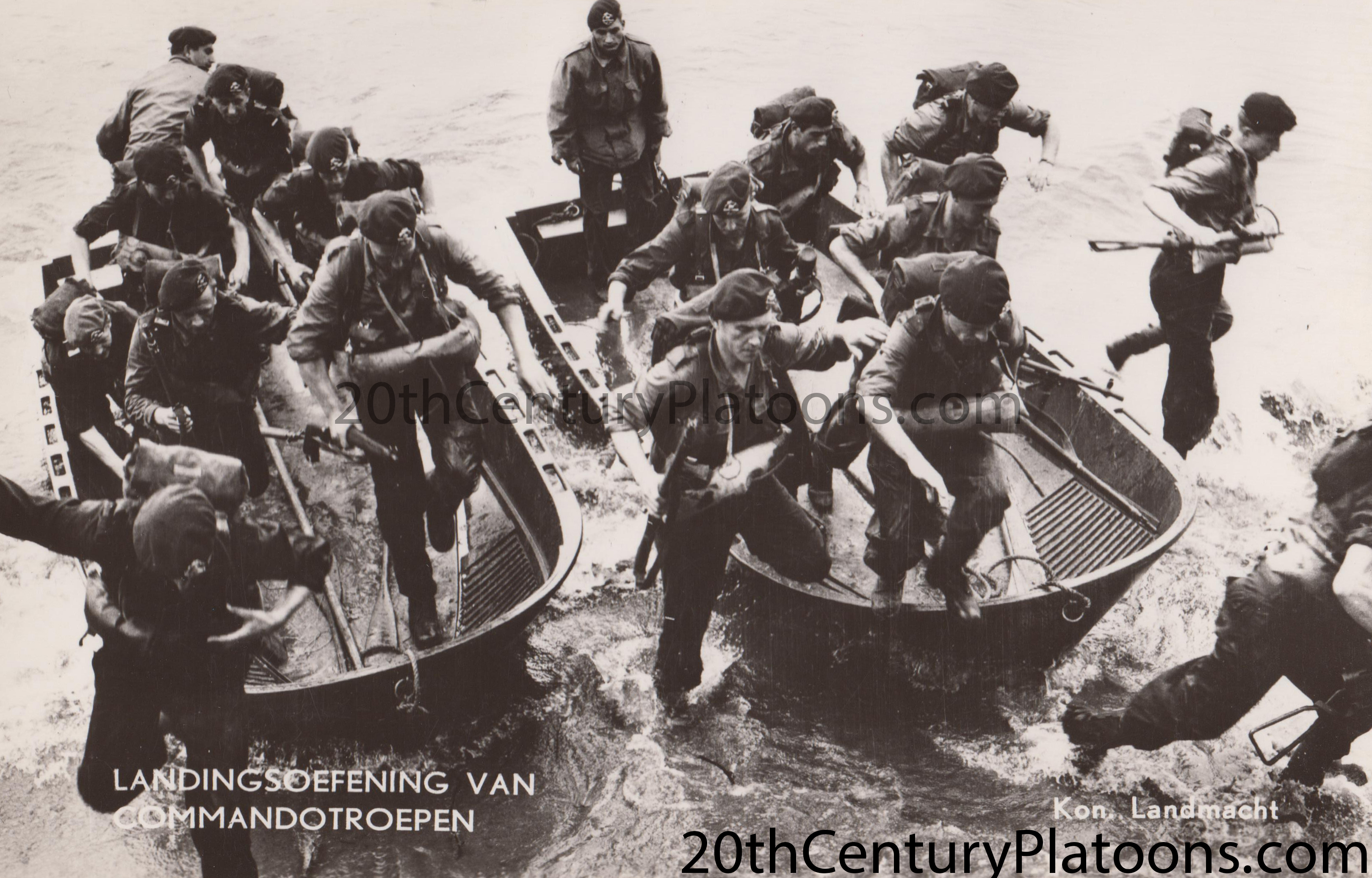
×
![]()
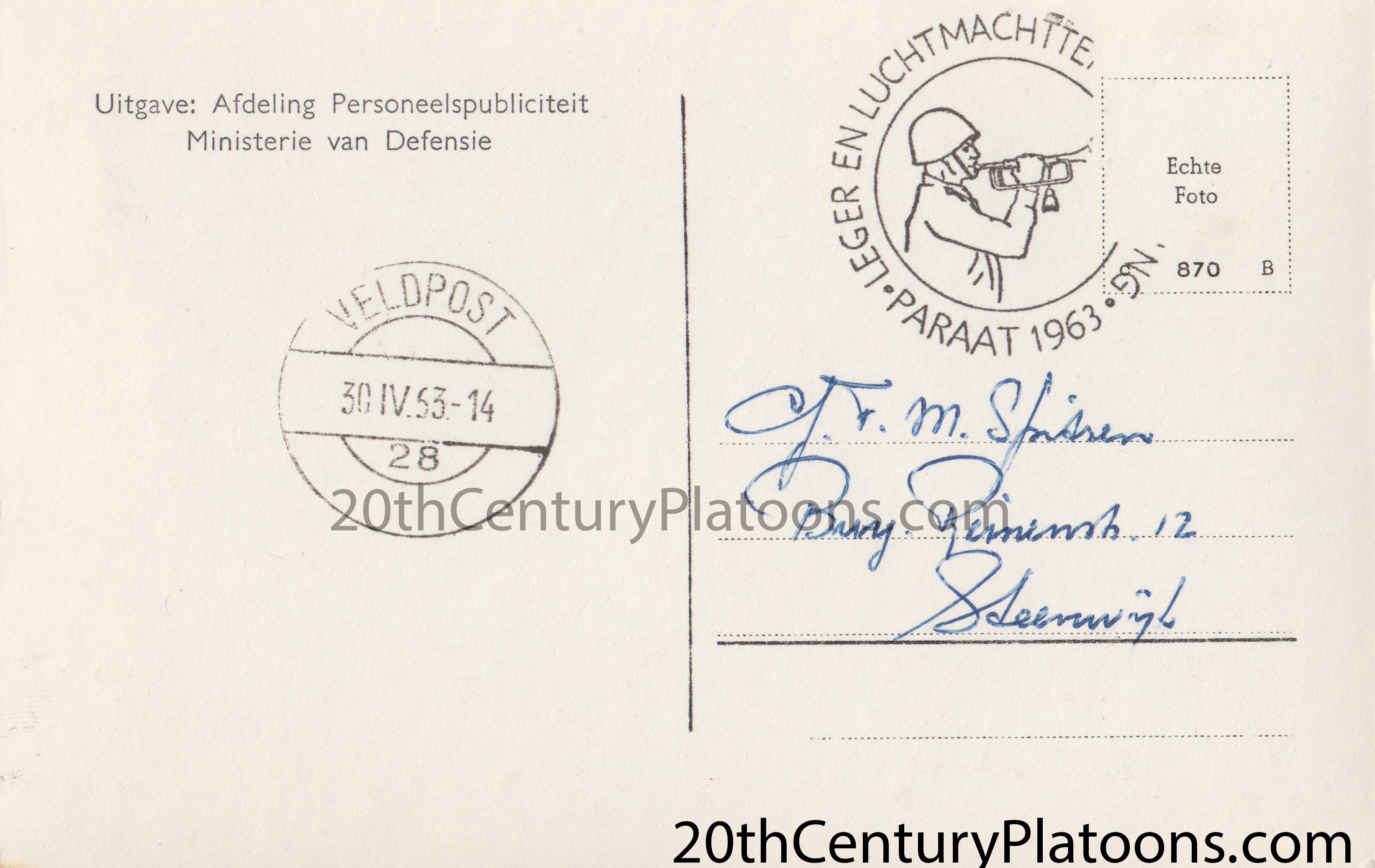
The front of the postcard reads: "Landing exercise of the Commandos, Royal (Dutch) Army". Meanwhile, the reverse has two stamps, both of which dating it to 1963.
As for the weapons shown, we see a collection of World War II-era British small arms.
Click here to continue reading.
Click here to see all postcards.
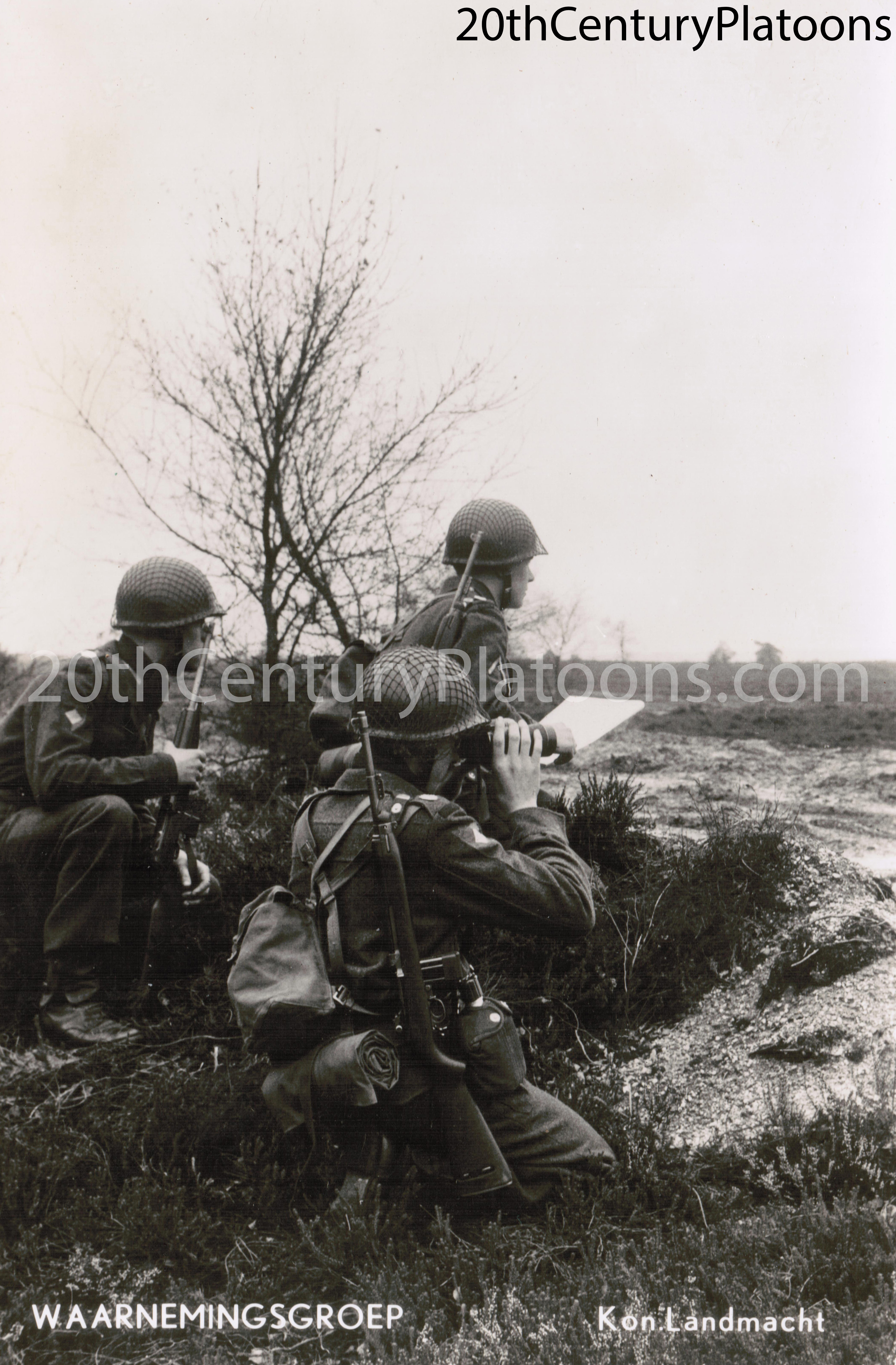
×
![]()
The above undated postcard shows a waarnemingsgroep of the Koninklijke Landmacht.
Judging by the uniforms, the picture was taken somewhere in the 1950s or 60s.
Click here to continue reading.
Click here to see all postcards.
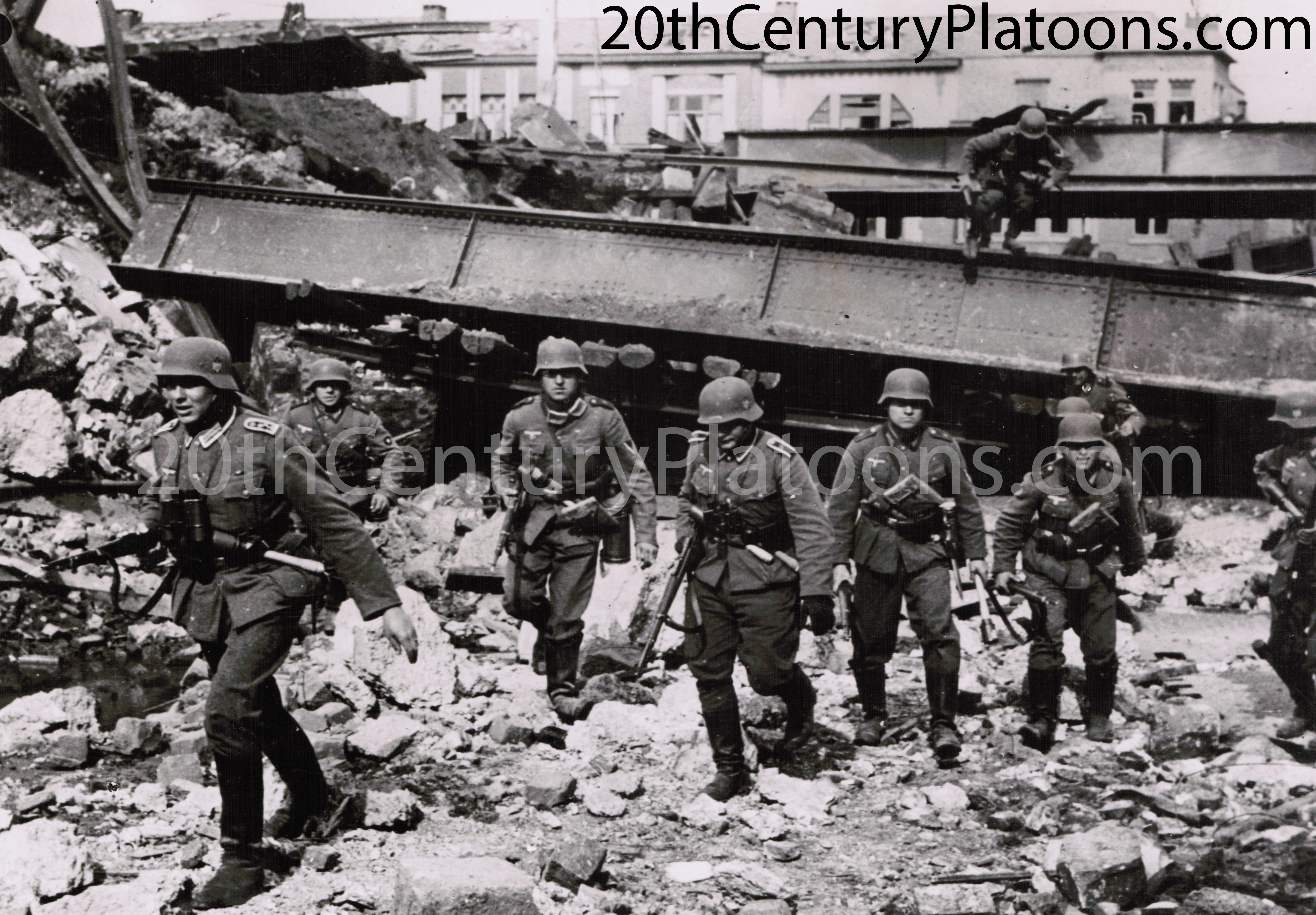
×
![]()
Displayed above is a German press photo showing a Spähtrupp advancing past a destroyed bridge, 7th of June 1940
Characteristic of the early campaigns, a number of the men can be clearly seen wearing their gas sheet pouches.
Click here to continue reading.
Click here to see all postcards.
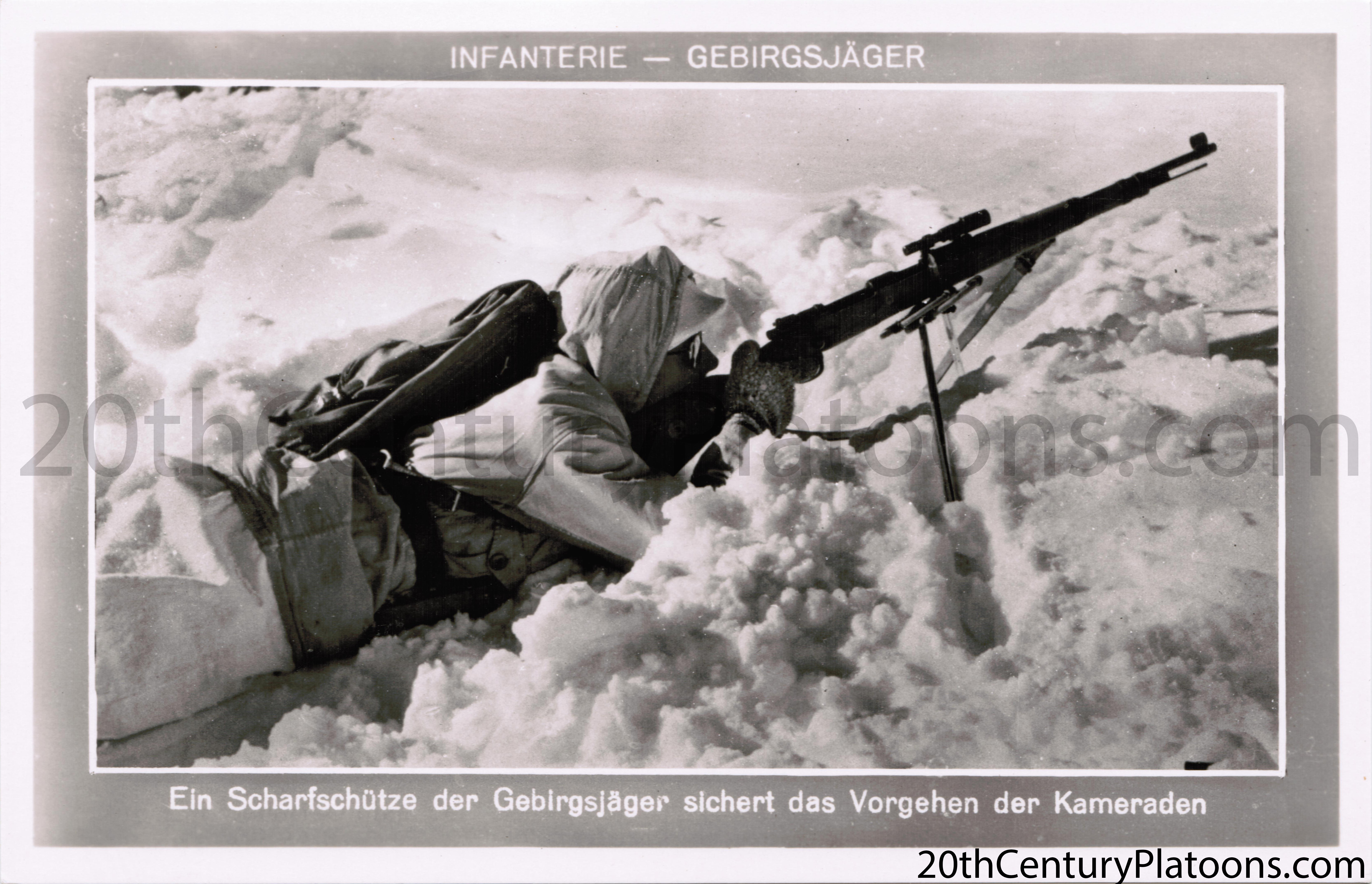
×
![]()
The above postcard shows a German Gebirgsjäger securing the advance of his comrades.
Number four in an unknown series of propaganda postcards, the series of which this postcard was a part may -
judging by the title -
have showcased the various arms of service.
Click here to continue reading.
Click here to see all postcards.
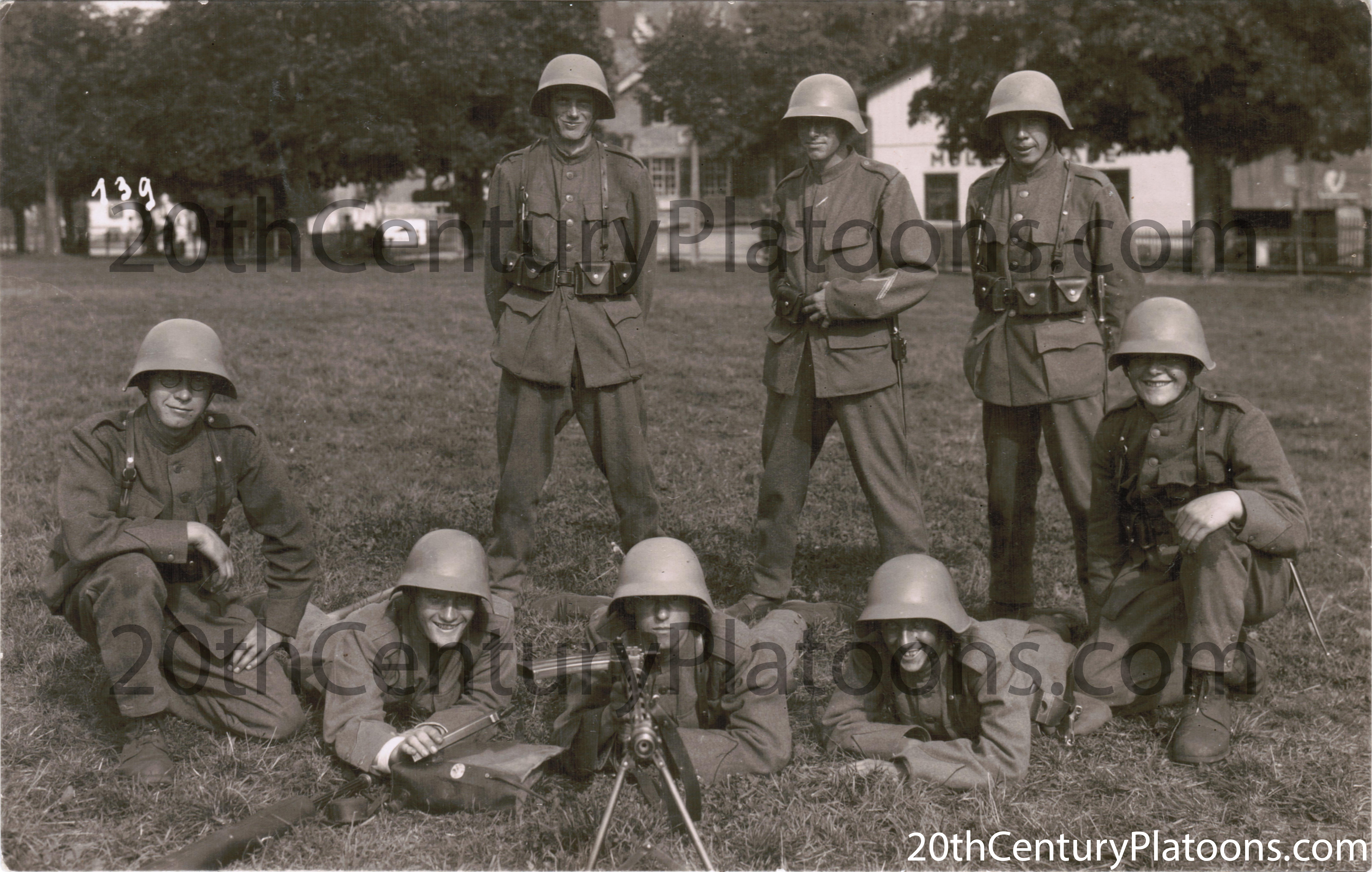
×
![]()
This undated postcard shows a group of Swiss soldiers with an Lmg 25 light machine gun.
Though the postcard itself does not give us an exact date, the helmets in combination with the weapon date this image from 1925 to 1944.
Click here to see all postcards.

×
![]()
Today's manual concerning the Pistolet automatique de la
manufacture d'armes de Saint-Etienne 9 mm G1 is a license-produced Beretta 92FS,
in use since 1989 with the Gendarmerie and since 1992 with the armed forces in general.
Interestingly, the weapon does not appear to be in widespread use, something confirmed by the 1999 rifle platoon
structure which will be discussed soon.
The manual is available for download here.
The archive of all manuals is available here.
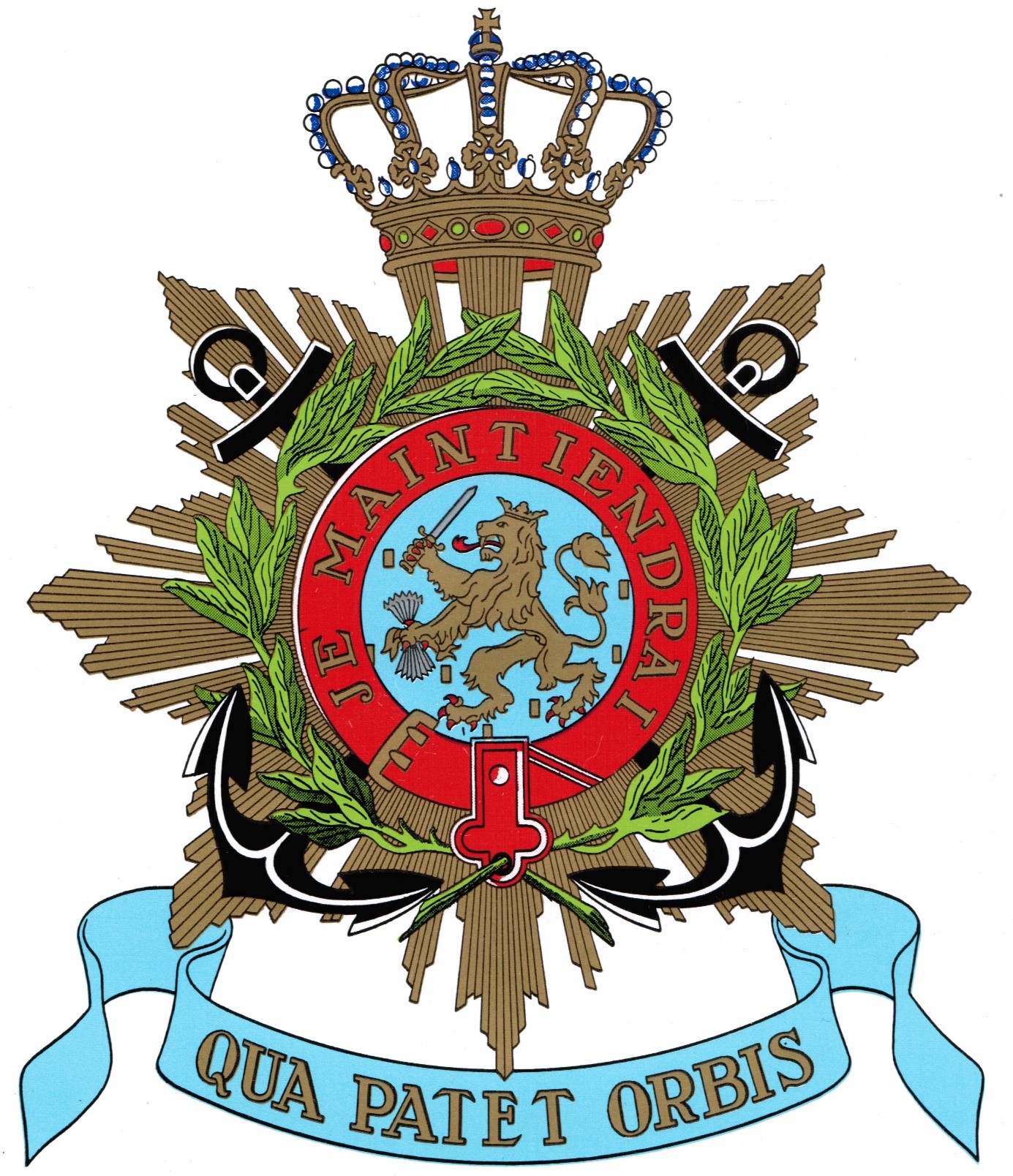
×
![]()
Introduction
Following the end of the Cold War, the Dutch Marine Corps reoriented itself from its role on NATO’s Northern flank
(as described in the 1978 post) to a more expeditionary role in both a humanitarian and peacekeeping context.
This included the 1991 Operation “Safe Haven” (also known as Provide Comfort) in Northern Iraq and Turkey, the 1992-93
UN missions UNAMIC and UNTAC in Cambodia, a 1994 UN mission in Rwanda, the 1995-96 UN mission UNMIH in Haiti, and the
(then-ongoing) UN operation in former Yugoslavia.
The 1990s saw a transition in terms of equipment as well, with the Browning High Power being replaced by the Glock 17,
and the FN FAL being replaced by the Diemaco.
Click here to continue reading.
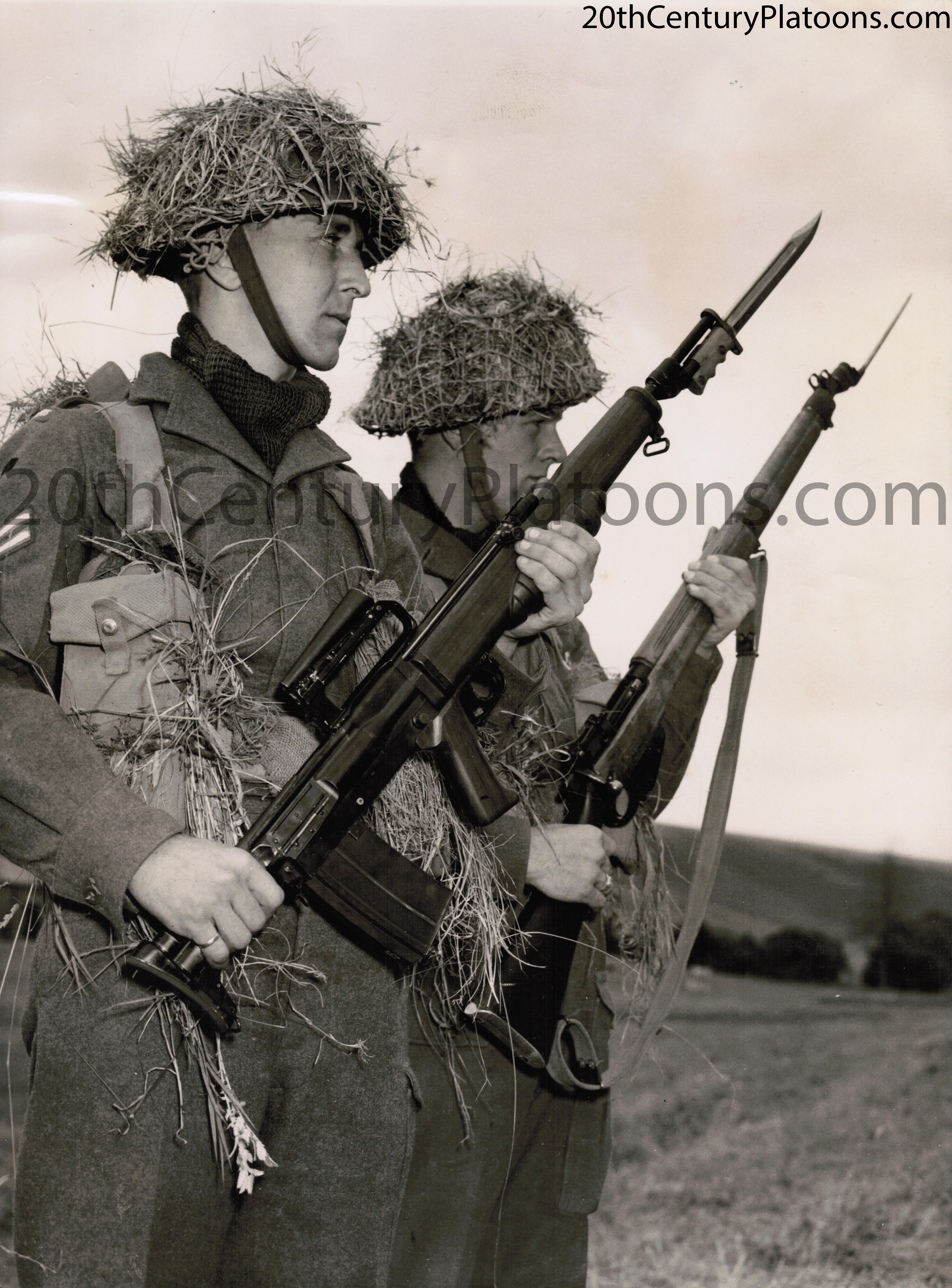
×
![]()
This press photo dated circa 1948-1951 (the period during which the rifle was tested) shows the EM-2 assault rifle.
Though the rifle was innovative with its layout, optic, and cartridge, it ultimately did not entered mass-production.
The back of the photo reads as follows:
"The .280 rifle is demonstated
The new .280 service rifle (foreground) is held by Corporal E. Unsworth of Bedford at a demonstration at the
School of Infantry at Warminster on the edge of the Salisbury Plain, today, August 10. New small arms weapons were viewed
by M.P.S and high-ranking British and overseas officers. Behind is the present service rifle, the number four Lee Enfield.
Chief differences between the two weapons are higher rate of fire in the .280 which is lighter and shorter than the older
rifle."
Forgotten Weapons has more information on the weapon, whilst a manual concerning the EM-2 can be found here.
Click here to see all postcards.

As part of the
Handboek voor de Marinier 1978 - whose contents are discussed here - chapter 12 concerning the FN FAL rifle is displayed and available for download here.
Dutch use of the FN FAL is a topic worth examining further, and it most certainly will be in the future.
In short, the weapon was adopted by the Army, Navy, and Airforce in 1961, with the latter two branches also adopting the FALO automatic rifle. The weapon served until replaced by the Diemaco in 1995, though it would take some years before the weapon was well and truly done away with.
The archive of manuals can be found here.

×
![]()
Introduction
For today’s post, we will consider the 1978 infantry platoon of the Dutch Marine Corps (Korps Mariniers).
During the second half of the Cold War, the Dutch Marine Corps played a role on NATO’s Northern flank in
Norway. As part of the British 3 Commando Brigade, the 1 Amphibious Combat Group could be quickly deployed
to Northern Norway to meet Soviet aggression. Befitting its role in Norway, 1 ACG was trained for mountain
and arctic warfare.
Meanwhile on the other side of the spectrum – and planet for that matter – 2 Amphibious Combat Group was
stationed on the Dutch possessions in the Caribbean, principally Curaçao and Aruba.
Trained in jungle warfare, these units could be deployed to the UK/NL Landing Force,
but only to non-arctic areas.
Click here to continue reading.
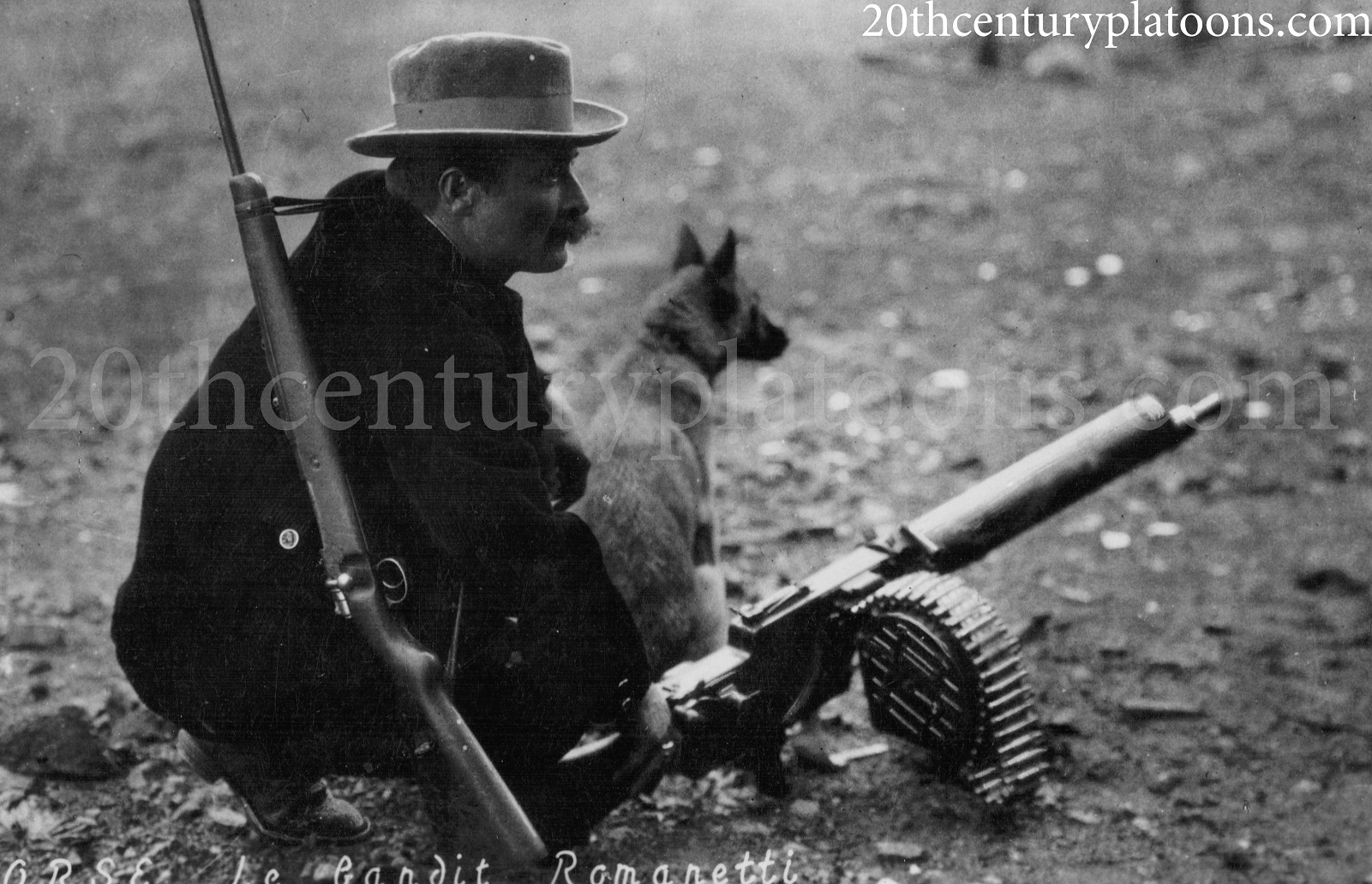
Though the subject pictured is not a soldier, he has quite the military hardware. This postcard shows Nunzu Romanetti (1882-1926) - a bandit from the French island of Corsica - with his (Mauser?) rifle and MG08/15 machine gun.
With no exact date for this photograph, I estimate it to have been taken between 1918 and 1926. The former date is the end of World War I, after which the French would capture large amounts of German equipment, whilst the latter is Romanetti's year of death.
Click here to see all postcards.
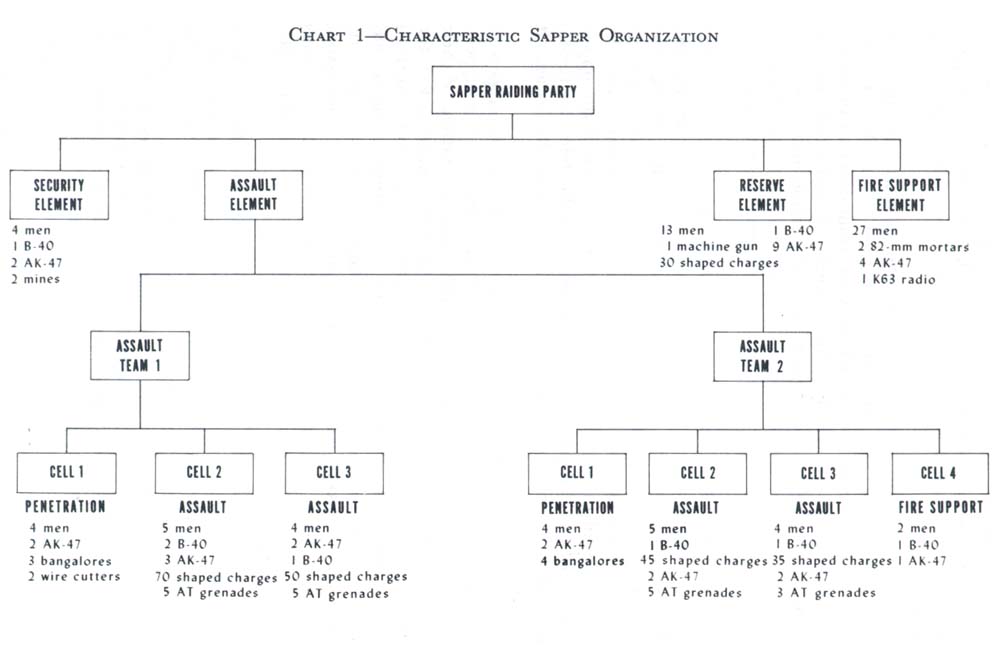
This image from the book "Vietnam Studies: Field Artillery 1954-1973" by Major General David Ewing Ott shows the organization of NVA and PLAF sappers.
The chart is accompanied by the following text:
"No description of the North Vietnamese Army and the People's Liberation Armed Force and their effect on allied forces would be complete without mention
of the ubiquitous sapper. During the first half of 1969, sapper attacks inflicted an average of over $1 million damage per raid. However, the role of the
sapper was often misunderstood. Before 1967, the enemy had not grasped the significance of the sapper as an assault soldier. The allies, on the other hand,
sometimes erroneously categorized the sapper as a guerrilla simply because some guerrillas employed sapper tactics. The fusion blurred identification. The
development of the sapper and his employment before and after the creation of a separate sapper combat arm, equivalent to the infantry and artillery, must
be traced before his impact on the war can be appreciated.
Click here to continue reading.
The book is available for download here.
All resources can be found here.

This 1989 reprint of a 1984 manual describes the
"
LRAC", a weapon is use since 1968,
used at the squad and platoon level until 1986, when it was replaced at the squad level by the RAC 112.
It was retained at the platoon level until 1999, when it was replaced by the ERYX.
The weapon nonetheless served until 2012, based on the 2012 edition of the TTA150 manual.
The manual is available for download here.
The archive of manuals can be found here.

×
![]()
Introduction
Following the loss of Dutch New Guinea in 1962,
the Dutch marine corps found itself between a rock and a hard place.
Indeed, the possibility of dissolving the nearly 300-year old corps was discussed.
Nonetheless, the Korps Mariniers continued to modernize, replacing its American weapons acquired in
the 1943-1945 period. Whilst the M1911A1 and Thompson M1 had been replaced in 1958 and 1959 respectively,
the Garand and M1918A2 BAR were soon to follow. With these new weapons, so too the organisation changed.
Prologue
This post is based on the Voorontwerp van een voorschrift betreffende de tactiek van de geweergroep
(Provisional design of a manual concerning the tactics of the rifle squad), dated 1st of June, 1963.
As a provisional manual, it is impossible to say with certainty how long – if at all – the organisation
described was in use. Nonetheless, it provides us with a look at how the Dutch marine corps sought to
incorporate its new generation of weaponry.
Click here to continue reading.
- 26th of September, 2021
The website's layout has been changed, displaying the five most recent page on the home page, with a longer list of all posts found on the second page.
- 23rd of June, 2018
The third and final article concerning the Dutch Marine Corps has been published.
- 14th of June, 2018
The second article - the Dutch Marine Corps 1978 - has been published.
Images now open as a pop-up.
- 7th of June, 2018
The first resource - concerning the Vietnamese sappers - is added.
- 5th of June, 2018
Interactive footnotes are added to the Dutch 1963 Marines Corps article.
The first manual is added.
- 4th of June, 2018
The first scanned postcard is added.
- 3rd of June, 2018
The first article - concerning the Dutch Marine Corps 1963 - is created.
- 2nd of June, 2018
The website is created and launched.



